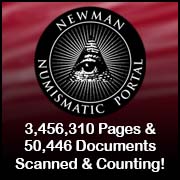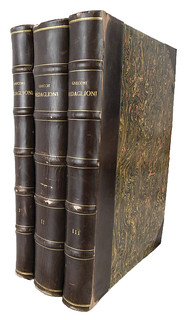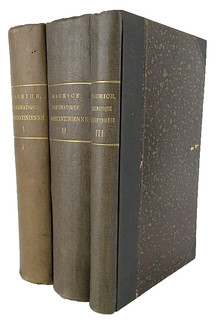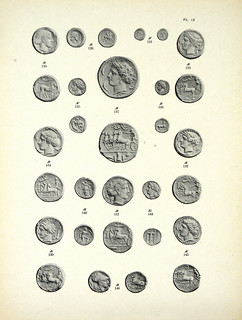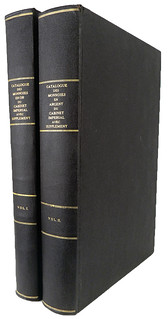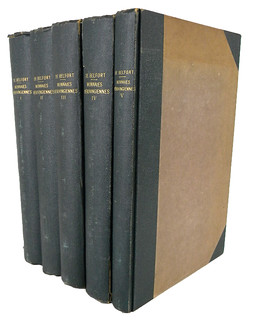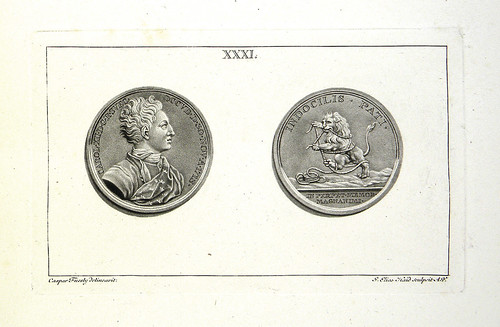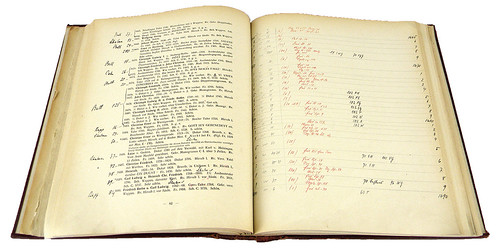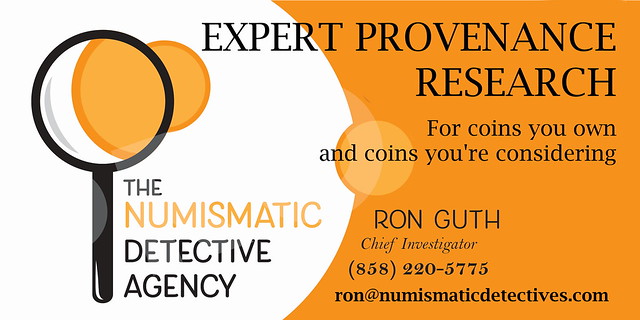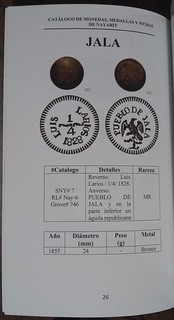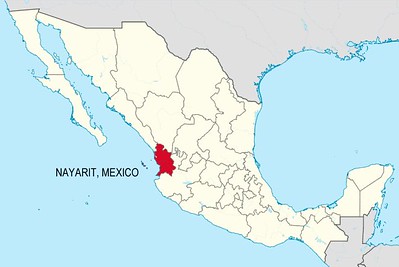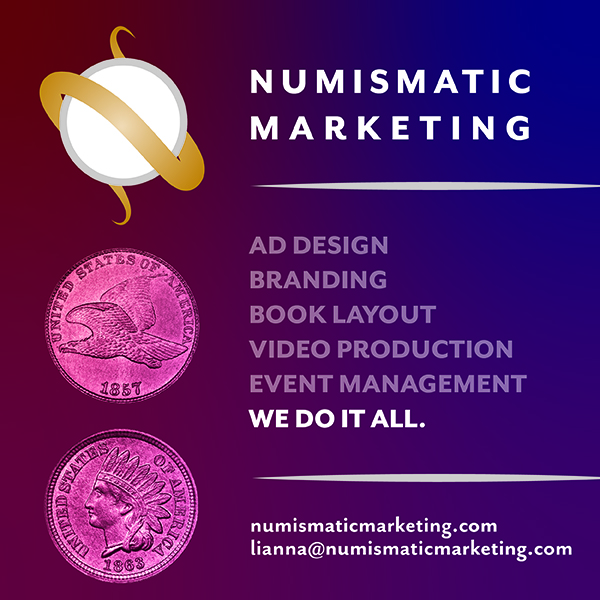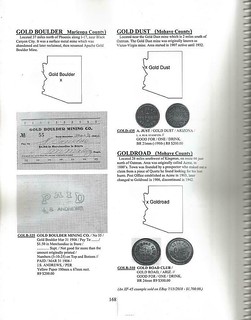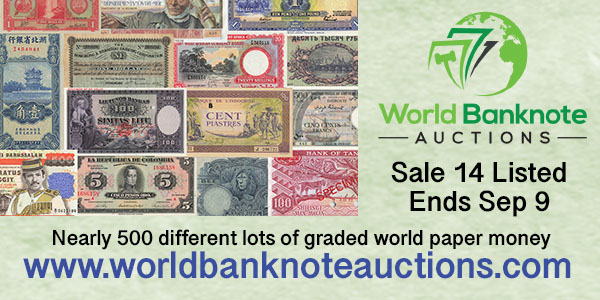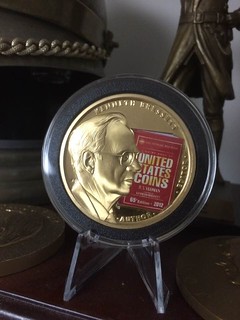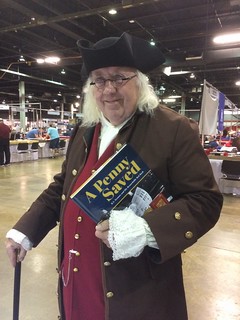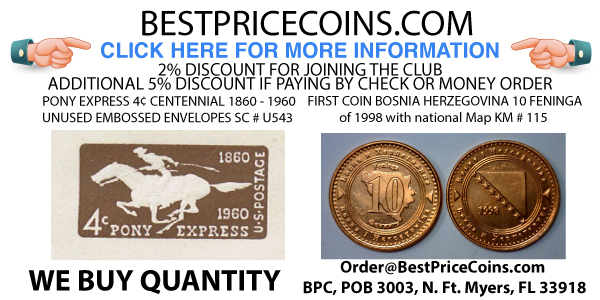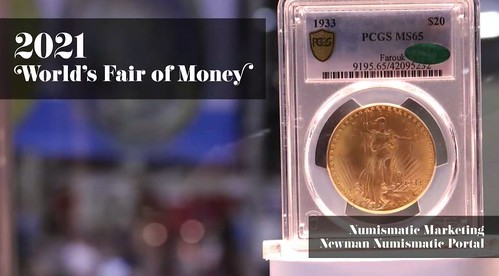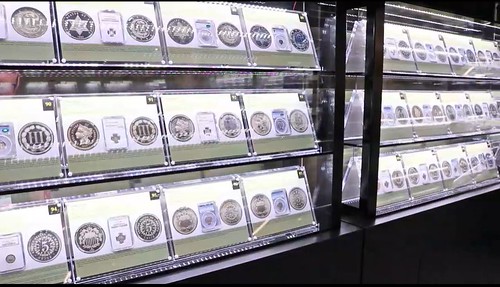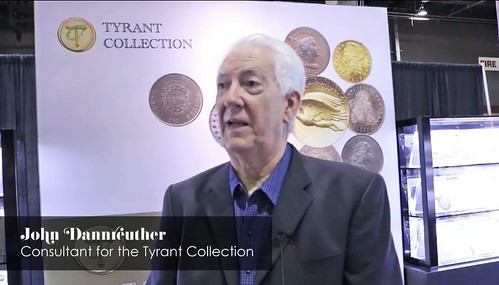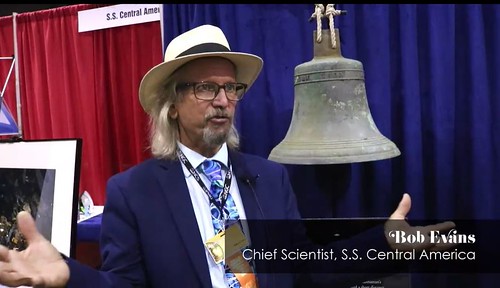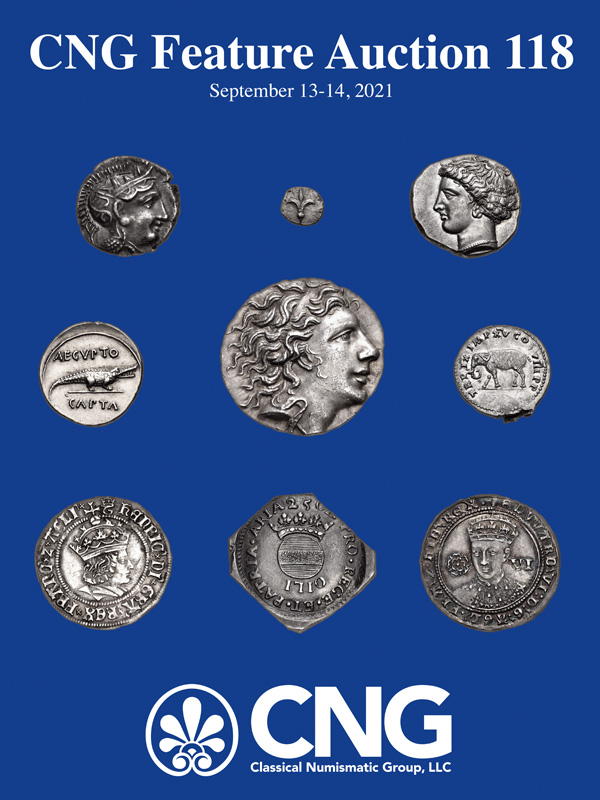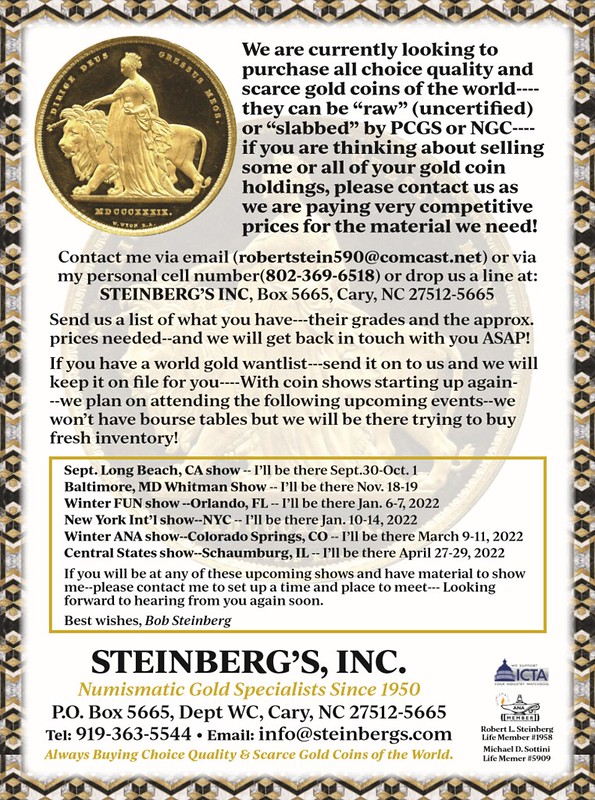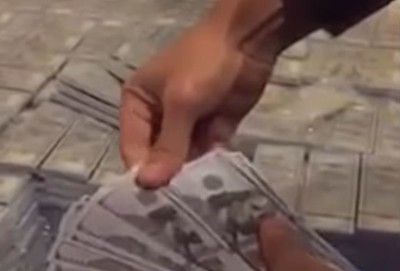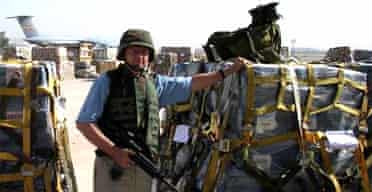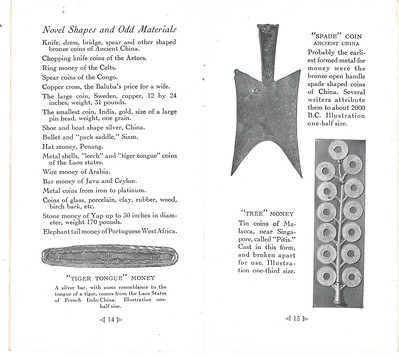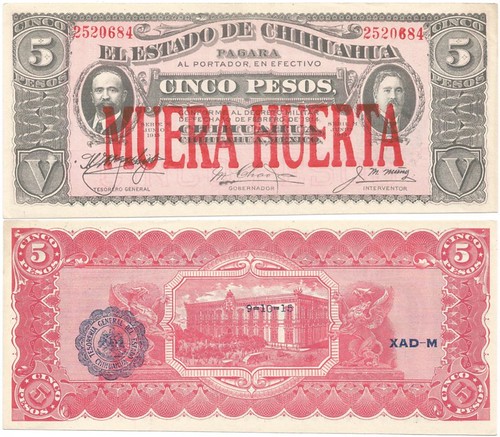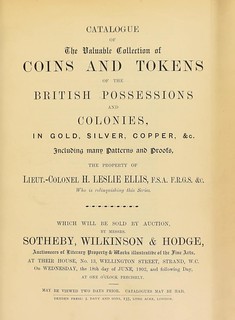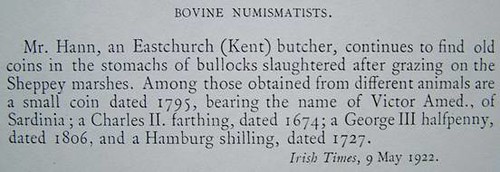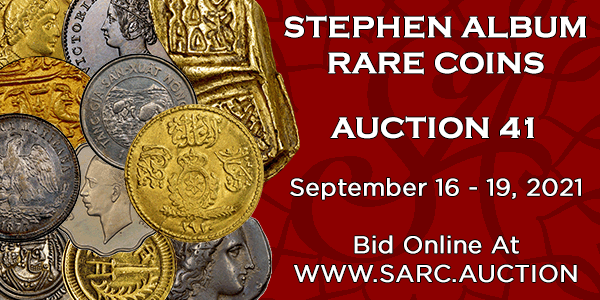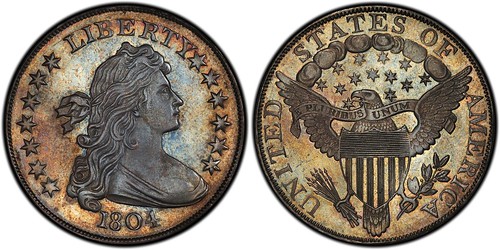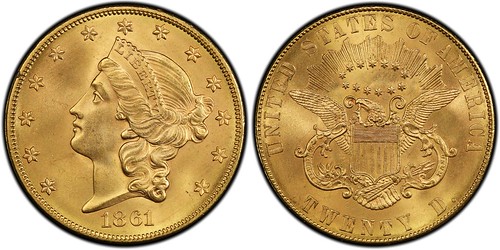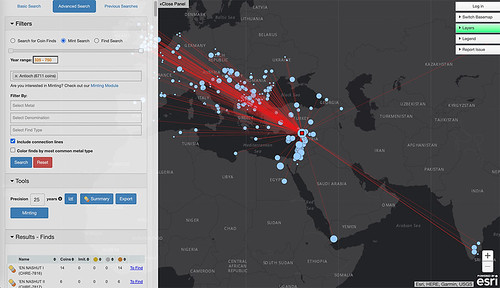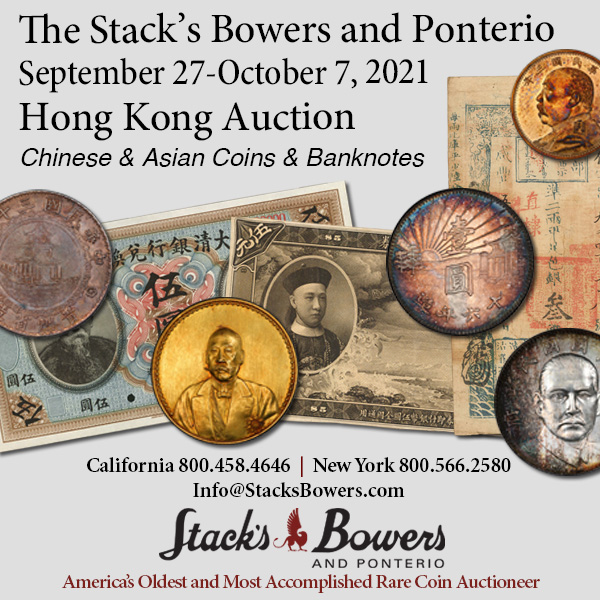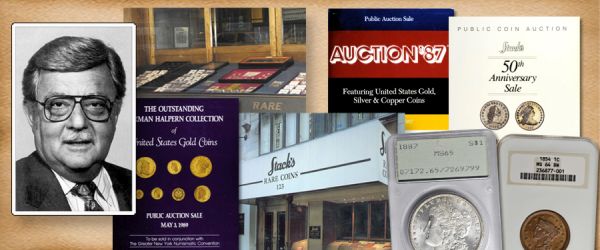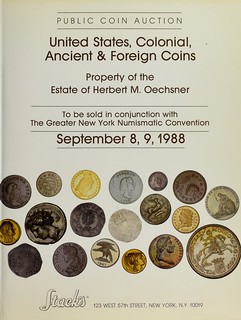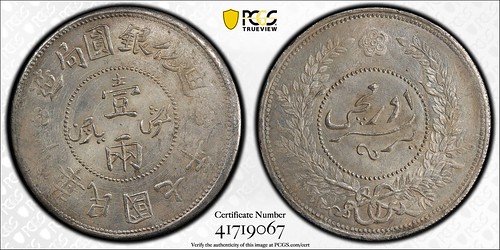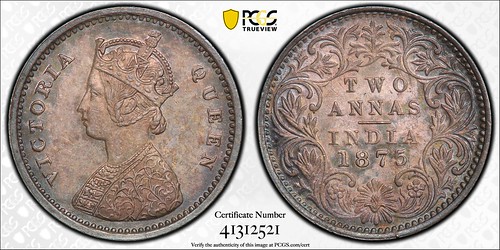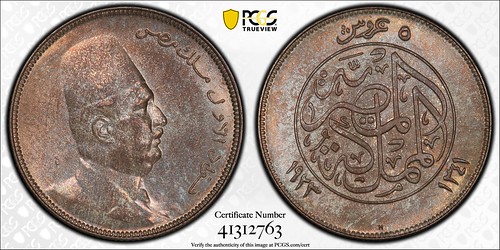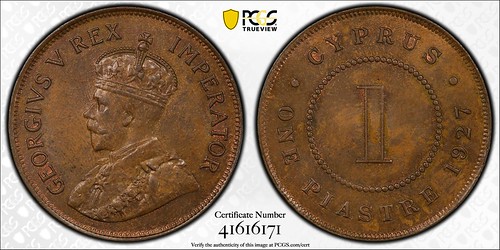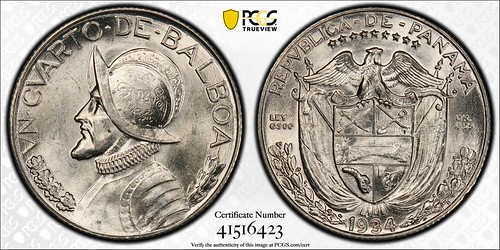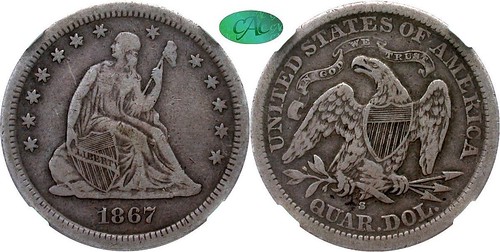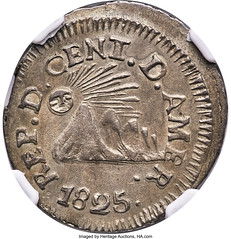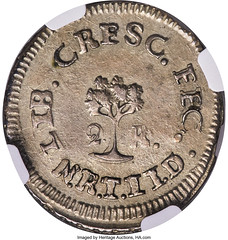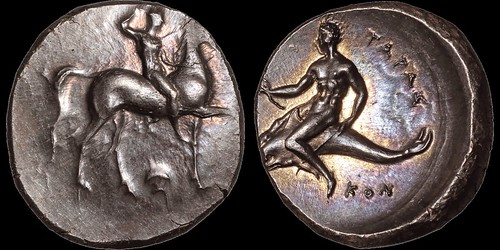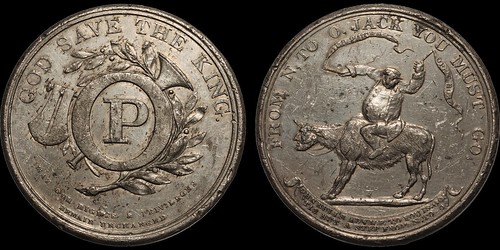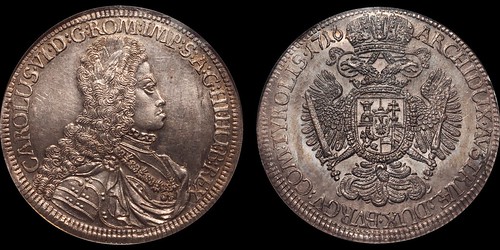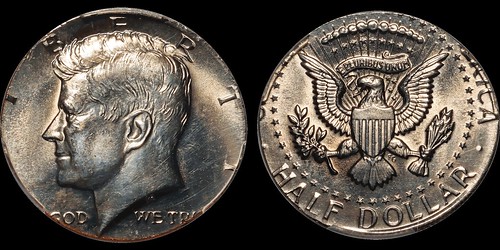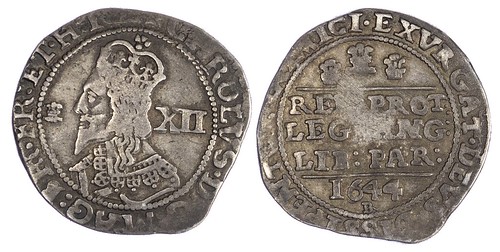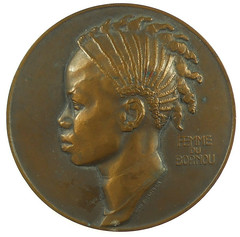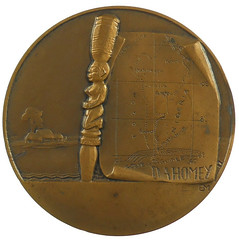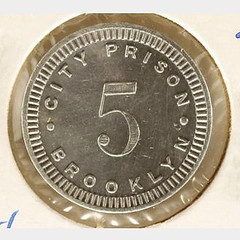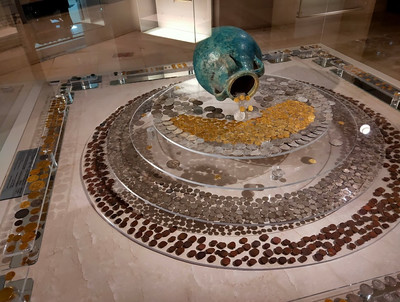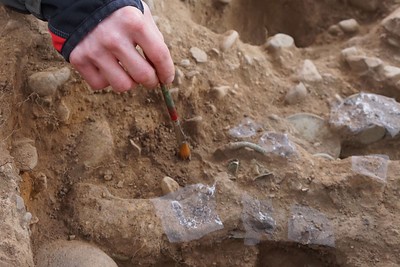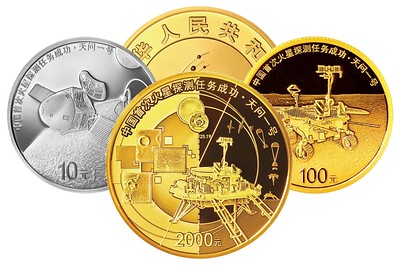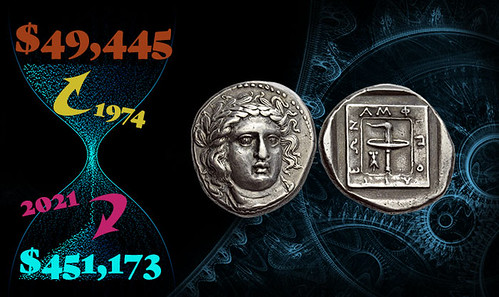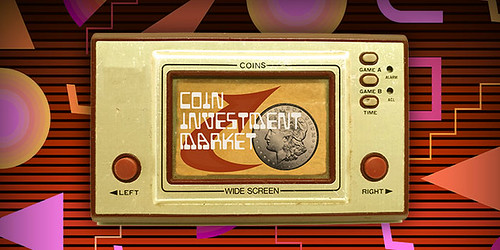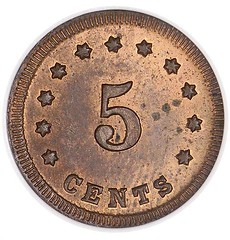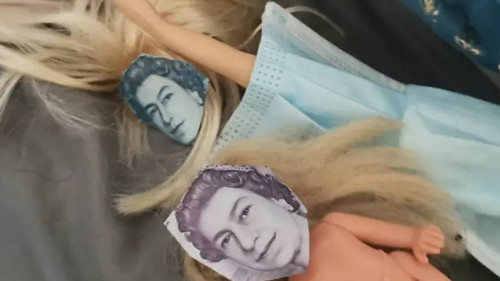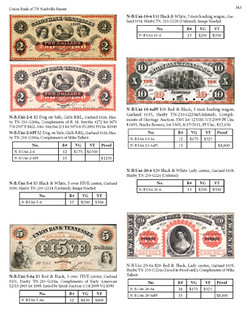
Visit our NBS Sponsors


About UsThe Numismatic Bibliomania Society is a non-profit association devoted to the study and enjoyment of numismatic literature. For more information please see our web site at coinbooks.org SubscriptionsThose wishing to become new E-Sylum subscribers (or wishing to Unsubscribe) can go to the following web page link MembershipThere is a membership application available on the web site Membership Application To join, print the application and return it with your check to the address printed on the application. Print/Digital membership is $40 to addresses in the U.S., and $60 elsewhere. A digital-only membership is available for $25. For those without web access, write to: Charles Heck, Treasurer AsylumFor Asylum mailing address changes and other membership questions, contact Chuck at this email address: treasurer@coinbooks.org SubmissionsTo submit items for publication in The E-Sylum, write to the Editor at this address: whomren@gmail.com BUY THE BOOK BEFORE THE COINSale CalendarWatch here for updates! |
- WAYNE'S WORDS: THE E-SYLUM AUGUST 29, 2021
- KOLBE & FANNING SALTON LIBRARY SALE
- KOLBE & FANNING BUY OR BID SALE NUMBER 16
- SOLIDUS LITERATURE AUCTION 77
- NEW BOOK: COINS, MEDALS AND TOKENS OF NAYARIT
- NEW BOOK: ARIZONA TRADE TOKENS 2021
- A BOOK ABOUT NUMISMATIC PUBLISHING
- LOUIS HAROLD COLLINS (1941-2021)
- VIDEO: 2021 ANA WORLD'S FAIR OF MONEY
- VIDEO: ERROR COLLECTORS GROUP CONECA
- ANA'S 130TH ANNUAL ACCOMPLISHMENT AWARDS
- ADDITIONAL 130TH ANNUAL ANA AWARDS
- NOTES FROM E-SYLUM READERS: AUGUST 29, 2021
- 2021 WORLD'S FAIR OF MONEY: JOHN BRUSH
- 2021 WORLD'S FAIR OF MONEY: IAN RUSSELL
- 2021 WORLD'S FAIR OF MONEY: HARRY LAIBSTAIN
- PRINCETON UNIVERSITY'S FLAME DATABASE
- VOCABULARY TERM: FINGERPRINT TECHNOLOGY
- WALDO NEWCOMER (1867-1934)
- HARVEY STACK'S NUMISMATIC FAMILY, PART 103
- STEPHEN ALBUM JUNE 2021 E-AUCTION 11 RESULTS
- GERRY FORTIN LIBERTY SEATED QUARTER RESULTS
- HERITAGE CENTRAL AMERICAN REPUBLIC (CAR) SALE
- DAVISSON'S E-AUCTION 41
- NUMISMATIC NUGGETS: AUGUST 29, 2021
- MUSEUM OF ISLAMIC ART COIN HOARD DISPLAY
- DETECTORISTS AND ARCHAEOLOGISTS TOGETHER
- CHINA'S MARS MISSION COINS
- LOOSE CHANGE: AUGUST 29, 2021
- GIRL CUTS QUEEN'S FACE FROM BANKNOTES
- FEATURED WEB SITE: SCHAFLUETZEL'S
Click here to read the thin version on the web
Click here to subscribe
Click here to access the complete archive
To comment or submit articles, reply to whomren@gmail.com
Content presented in The E-Sylum is not necessarily researched or independently fact-checked, and views expressed do not necessarily represent those of the Numismatic Bibliomania Society.
WAYNE'S WORDS: THE E-SYLUM AUGUST 29, 2021
 New subscribers this week include:
Steve Feltner, courtesy John Dannreuther;
José Antonio Pimienta courtesy Adrián González-Salinas;
Robert Cavalier,
Dale Rooke, and
Alex Zaitchik.
Welcome aboard! We now have 6,682 subscribers.
New subscribers this week include:
Steve Feltner, courtesy John Dannreuther;
José Antonio Pimienta courtesy Adrián González-Salinas;
Robert Cavalier,
Dale Rooke, and
Alex Zaitchik.
Welcome aboard! We now have 6,682 subscribers.
Thank you for reading The E-Sylum. If you enjoy it, please send me the email addresses of friends you think may enjoy it as well and I'll send them a subscription. Contact me at whomren@gmail.com anytime regarding your subscription, or questions, comments or suggestions about our content.
This week we open with three numismatic literature sales, two new books, updates from the Newman Numismatic Portal, ANA accomplishment awards, and more.
Other topics this week include Arizona trade tokens, reports from the 2021 ANA World's Fair of Money, "fingerprint technology", Waldo Newcomer, auction results and previews and Mars mission coins.
To learn more about The Tyrant Collection, CONECA, Ellen Feingold, Barbara Gregory, Dick Johnson, Kellen Hoard, Kerry Wetterstrom, macerated currency postcards, the Chase Manhattan Bank Money Museum, bovine numismatists, FLAME, the Central American Republic, prison tokens, the Museum of Islamic Art, the ghost of Thomas Jefferson and the negotiable cow, read on. Have a great week, everyone!
Wayne Homren
Editor, The E-Sylum
KOLBE & FANNING SALTON LIBRARY SALE
Kolbe & Fanning have announced their next numismatic literature sale. -Editor
Salton Library to be sold September 18
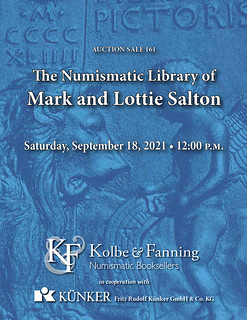 Kolbe & Fanning Numismatic Booksellers are proud to announce that on September 18, 2021, we will be selling at auction the extraordinary library formed by Mark and Lottie Salton. The Salton Library is especially rich in works devoted to ancient coins and the medallic arts, and is notable for its extensive holdings of European auction catalogues, many of which are heavily annotated. The couple's broad numismatic interests are reflected in their wide-ranging library, which includes material on coins from all over the world. We are offering the library in cooperation with Fritz Rudolf Künker, of Osnabrück, Germany.
Kolbe & Fanning Numismatic Booksellers are proud to announce that on September 18, 2021, we will be selling at auction the extraordinary library formed by Mark and Lottie Salton. The Salton Library is especially rich in works devoted to ancient coins and the medallic arts, and is notable for its extensive holdings of European auction catalogues, many of which are heavily annotated. The couple's broad numismatic interests are reflected in their wide-ranging library, which includes material on coins from all over the world. We are offering the library in cooperation with Fritz Rudolf Künker, of Osnabrück, Germany.
Some highlights of the sale include:
Lot 5: an original set of Ernest Babelon's classic Traité des monnaies grecques et romaines
Lot 51: Francesco Gnecchi's magnificent three-volume I Medaglioni romani (1912), an extraordinary work on Roman medallions
Lot 83: a complete set of Jules Maurice's scarce and important Numismatique constantinienne
Lot 114: the best edition of the rare illustrated catalogue of the collection formed by the Vicomte de Sartiges, complete with supplement and 48 very fine plates
Lot 147: both volumes of the magnificent 1759–1770 folio catalogues of the Vienna cabinet, prepared for Empress Maria Theresa, with both supplements
Lot 174: an original set of Auguste de Belfort's Description générale des monnaies mérovingiennes...
Lot 222: Mark & Lottie Salton's working copy of Hill's extraordinary 1930 Corpus of Italian Medals of the Renaissance before Cellini
Lot 241: a very rare 1782 folio by Jean Gaspard Fuesli on the medallic work of Johann Carl Hedlinger, illustrated with exceptional mezzotint engravings
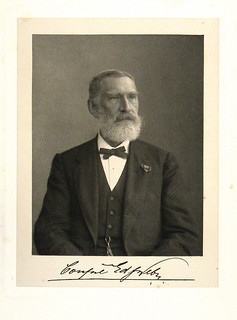 Lot 368: Jacob Hirsch's 1908 auction catalogue of the Eduard Friedrich Weber collection of Greek coins (Hirsch's catalogue of Weber's Roman coins is also featured, as lot 370)
Lot 368: Jacob Hirsch's 1908 auction catalogue of the Eduard Friedrich Weber collection of Greek coins (Hirsch's catalogue of Weber's Roman coins is also featured, as lot 370)
Lot 424: the original bidbooks for the auctions held by Felix Schlessinger (Mark Salton's father) between 1928 and 1937, recording bids received, buyers, prices, etc., and with additional materials laid in.
Register early to bid online
Bids may be placed via post, email, fax or phone, as well as online. Kolbe & Fanning use Auction Mobility as our third-party online bidding platform. Auction Mobility is an app-based platform allowing users the ability to participate in the sale through phones, tablets and computers. To register for the sale, bidders must go to
bid.numislit.com and sign up. Once you have set up an account, you may browse lots, place advance bids, or participate in the live sale online. Those wishing to participate on their devices can download the Kolbe & Fanning app through the Apple or Google Play Store.
The printed catalogue of the Salton Library will soon be mailed to all active customers on our mailing list. As international mail speeds have been slow in recent months, we encourage our international clients to consult the electronic catalogue in case their printed catalogue does not arrive promptly. A PDF of the printed catalogue has been posted to our main website at numislit.com for those who prefer that format. Bids placed via post, email, fax or phone must be received by September 17, the day before the sale, in order for them to be processed. Advance absentee bids may also be placed at any time online at bid.numislit.com. Live internet bidding will be available during the sale itself through the same platform.
Mark and Lottie Salton represented a transitional period in the numismatic trade, being direct links between the European dealers of the era before the Second World War and the modern American coin trade of the post-war years. They were erudite and sophisticated in a manner rarely encountered today, and their generosity is well-known to many. We are honored to have been asked to catalogue the library, and are grateful to our partners at Fritz Rudolf Künker for their cooperation in what should be a memorable auction.
Kolbe & Fanning Numismatic Booksellers LLC is a licensed and bonded auction firm in the State of Ohio. For more information, please see the Kolbe & Fanning website at numislit.com or email David Fanning at df@numislit.com. To register for the sale, go to bid.numislit.com. We look forward to your participation.
KOLBE & FANNING BUY OR BID SALE NUMBER 16
Numismatic Booksellers Kolbe & Fanning submitted this announcement of their fifteenth "Buy or Bid Sale" which closes on September 7, 2021. Good luck, everyone! -Editor
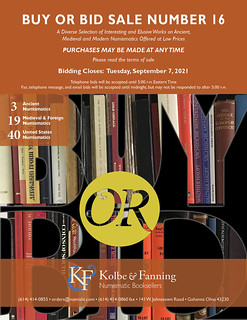 Kolbe & Fanning Numismatic Booksellers have announced our sixteenth
Kolbe & Fanning Numismatic Booksellers have announced our sixteenth Buy or Bid Sale,
which begins now and will close on Tuesday, September 7, 2021. With hundreds of new additions, the sale focuses on modestly priced books, giving collectors an opportunity to add to their libraries at minimal cost.
The sale includes over 1800 works on ancient, medieval and modern coins, as well as general works, periodicals and sale catalogues. Buy
prices have been kept low to promote sales. To further encourage participation, the firm is offering free domestic shipping to bidders spending at least $300; there is also no packing and processing fee for this sale. Again, please read the Terms of Sale before participating.
As the name of the sale suggests, customers may bid on items they wish to acquire or buy them outright at the published price. The Terms of Sale will give full instructions on how to participate: please read it carefully.
There is no printed catalogue. The PDF catalogue is available now for downloading from the Kolbe & Fanning website at numislit.com. Please send all bids to orders@numislit.com or use the bid sheet included at the end of the PDF catalogue
SOLIDUS LITERATURE AUCTION 77
Solidus Numismatik e.K of Munich, Germany is also holding a September numismatic literature sale. Here's their announcement. -Editor
We would like to draw your attention to our 7th literature auction with 1531 lots, for which you can already submit pre-bids:
Literature Auction 77 - live auction on September 12, 2021 from 10:00 a.m. CEST.
Link to Auex: https://solidus-numismatik.auex.de/Auktion/Onlinekatalog?intAuktionsId=1135
The online catalog is illustrated.
You can download a PDF catalog (without images) here: https://www.solidus-numismatik.de/fileadmin/user_upload/Download/A_77_Text.pdf
The auction contains numerous bibliophile rarities, including books from the Günther Hofmann library, as well as high-quality current, partly out of print and rare specialist literature from Antiquity to the Middle Ages and Modern Times as well as books on general numismatic subjects. Festschriften and magazines round off the auction.
A printed catalog will be published for the auction. We would ask you to give us a brief feedback if you want us to send it to you.
We hope you enjoy browsing through the auction!
NEW BOOK: COINS, MEDALS AND TOKENS OF NAYARIT
Adrián González-Salinas submitted information about another new book on Mexican numismatics. Thanks. -Editor
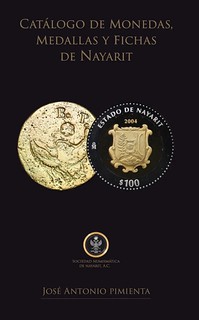 Book: Catálogo de Monedas, Medallas y Fichas de Nayarit
(Catalog of Coins, Medals and Tokens of Nayarit, Mexico)
Book: Catálogo de Monedas, Medallas y Fichas de Nayarit
(Catalog of Coins, Medals and Tokens of Nayarit, Mexico)
Author: José Antonio Pimienta
Year: First Edition 2021
Size (cms): 13.6 x 21.0 x 0.6 (half letter page)
Pages: 80
Full Color
This is the very first numismatic catalog related to the Mexican state of Nayarit (west of Mexico) It catalogs 11 Hacienda Tokens (some of them are very rare), 4 trade tokens, one monogram token, 4 spurious tokens, 3 mining stocks, 18 medals and 6 coins minted by Mexico City Mint (founded 1536).
Also, this publication uses catalog numbers of Mauricio Fernández-Garza, Frank W. Grove, Russell Rulau, Krause-Mishler and it added its own catalog number for tokens, medals and coins: SNY#, SNY-M# and SNY-Mo#. Each token is assigned a rare scale such as C (Common), E (Scarce), R (Rare) and MR (Very Rare). The author can be reached at joseantoniopimienta@gmail.com
NEW BOOK: ARIZONA TRADE TOKENS 2021
Martin Bertelsen passed along information about the new edition of Peter Spooner's book on Arizona Trade Tokens. Thanks. The book is available in both full color and black and white versions. -Editor
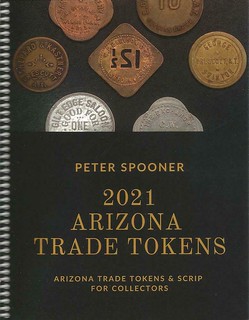 After 11 years of searching, researching, compiling and updating, this is the new
After 11 years of searching, researching, compiling and updating, this is the new Arizona Trade Tokens 2021
. It will take the place of the now Standard Reference
, read only, work on Arizona Trade Tokens. "Arizona Trade Tokens, 2010" by Peter Spooner.
Built upon the foundations of Arizona Trade Tokens
by the pioneer in the field, Hal Birt Jr. This new book expands from 294 in the 2010 book to 471 pages. It not only adds many new listings to the known items, but at least some historical information and a map on each and every town, village or location, many of them long gone.
This is a brand-new book and it will be shipped Media Mail
to anywhere in the USA, free of charge.
For more information, or to order, see:
"ARIZONA TRADE TOKENS 2021" In FULL COLOR by Spooner
(https://www.ebay.com/itm/203581915979)
"ARIZONA TRADE TOKENS 2021" in B&W by Peter Spooner
(https://www.ebay.com/itm/203581916142)
A BOOK ABOUT NUMISMATIC PUBLISHING
Publisher Dennis Tucker penned a Coin Update article about the debut of A Penny Saved: R.S. Yeoman and His Remarkable Red Book at the recent ANA World's Fair of Money. -Editor
Most numismatic books are about coins. A smaller number are about paper money, or tokens and medals (descending in quantity in that particular order). Fewer still focus on numismatic personalities, markets, specific historical factors, technology, and other aspects of the hobby (or art or science) of money.
Two weeks ago, at the American Numismatic Association World's Fair of Money, a Whitman book debuted that involves all of the above
and more. The new publication is A Penny Saved: R.S. Yeoman and His Remarkable Red Book.
LEFT: Retired editor of The Numismatist Barbara Gregory assisted Ken Bressett in the Herculean tasks of editing and writing, and reviewing and organizing archives from Western Printing and Lithographing Co. (the historical parent company of Whitman Publishing), sorting family photographs and artifacts, and studying other resources used in Ken's new book, A Penny Saved: R.S. Yeoman and His Remarkable Red Book.
RIGHT: Two titans of numismatic publishing. Neil Shafer (left) is a main character
in Ken Bressett's new A Penny Saved: R.S. Yeoman and His Remarkable Red Book. Neil worked for Whitman Publishing starting in the 1960s as a writer, editor, and researcher. His work in Philippine coins and paper money in particular, as well as the broader world of currency, is well known and includes reference books recognized as standards. He continues to blaze trails, writing for Bank Note Reporter and other publications.
A Penny Saved is a book about books . . . about the world of publishing . . . and specifically, the heady and rarefied world of numismatic book publishing.
While this might seem like the narrowest possible niche subject, it actually touches a thousand points in the history of coin collecting in America, going back to the 1800s and stretching to today's digital realm.
LEFT: A Rittenhouse Society medal created to honor Red Book editor Kenneth Bressett.
RIGHT: Ben Franklin (Patrick McBride) with A Penny Saved, at the ANA World's Fair of Money, August 2021.
One part of the story is the maturation of a small Racine, Wisconsin, print shop—West Side Printing Company—into the worldwide giant Western Printing and Lithographing Company. Another part of the story is the birth and gangbuster growth of Western's subsidiary, Whitman Publishing. Into Whitman's orbit came young Richard Yeo, whose public persona would become R.S. Yeoman. From Yeoman sprang the Guide Book of United States Coins and other innovative new books that would sell in the tens of millions. Then onto the scene came another prodigy, Kenneth Bressett. And on and on the story grows, with colorful connections, more books and hobby products, excursions into the United States Mint and the Treasury Department, the creation of new coins, and other adventures.
If you're a coin collector who likes a good story, immerse yourself in the wonderful world of A Penny Saved: R.S. Yeoman and His Remarkable Red Book. It will expand your understanding of our shared numismatic history, and rejuvenate your love of America's greatest hobby.
To read the complete article, see:
Notes Published: A book about numismatic publishing — A Penny Saved
(https://news.coinupdate.com/notes-published-a-book-about-numismatic-publishing-a-penny-saved/)
To read earlier E-Sylum articles, see:
NEW BOOK: A PENNY SAVED
(https://www.coinbooks.org/v24/esylum_v24n16a02.html)
AN EDITOR'S APPRECIATION FOR A PENNY SAVED
(https://www.coinbooks.org/v24/esylum_v24n20a05.html)
LOUIS HAROLD COLLINS (1941-2021)
Jeffrey Zarit passed along word of the passing of Heritage foreign coin specialist Louis Collins. Thank you. Sorry to hear the news. Here's an excerpt from his online obituary. -Editor
Louis Harold Collins
June 19, 1941 - August 9, 2021
Louis Harold Collins, 80, passed away on August 9, 2021, at the Delaney at Lake Waco. The service will be held at 2 p.m., Saturday, August 14, at Wilkirson-Hatch-Bailey Funeral Home, with Dr. Kourtney Aylor Lee officiating. Visitation will be one hour prior to the service. Graveside services will follow at Waco Memorial Park for immediate family.
Louis grew up in the Houston area, but loved the time he spent at the family cabin on the San Bernard River in Brazoria, where his passion for boats and boating was born. That passion grew into racing on lakes and rivers across America and eventually national championships and world records. Just a few weeks ago, from his hospital bed, Louis looked at his friend Chris Ray and said, "Let's ride." Louis and his wife Judy had a mutual friend Phyllis Trice, who "made sure" they met. Within six months, they married on February 6, 1983, at Peace Park in Salado.
Louis never did anything halfway! With the help of his Aunt Blanche, he began collecting and dealing coins at a young age, specifically world coins. Eventually, his passion turned into a profession and often satisfied his need for "what's next." In this professional capacity, Louis was honored to become a member of the National Numismatist Guild.
Louis spent many years as the foreign coin director in Dallas with Heritage Auctioneers and Galleries. After his retirement from the coin business, Louis moved to the Texas hill country to delight in the Highland Lakes. Maybe it was the beauty in those settings which captured his eye to venture into yet another occupation highlighting his great analytical ability, fine art. Louis had a real passion for western art and became a formidable presence at auctions across the country. Louis often identified value in art, not only monetarily, but also in the remarkable talent of artists.
Over the years, Louis shared his various passions and abilities with others. He could find the perfect home, or car, or piece of art for his friends and family. Many have received his solid advice, and to that, they're more than happy to attest.
Jeff adds:
"He was a ‘straight shooter' and could always tell me a story about other colleagues around the world. In my mind, his knowledge of world coins in this country was first rate and I know of only two others (both European) that could match his numismatic knowledge. He was very proud to be a PNG member.
"Many of his friends have passed away previously, including Doug Weaver, Jess Peters, Henry Christensen, Tom Becker, and many others. While an active coin dealer, he knew everyone in the trade. I still have some of his old price lists and I still treasure them for his numismatic knowledge."
To read the complete article, see:
Louis Harold Collins 1941 - 2021
(https://www.legacy.com/us/obituaries/wacotrib/name/louis-collins-obituary?pid=199741602)
VIDEO: 2021 ANA WORLD'S FAIR OF MONEY
The latest addition to the Newman Numismatic Portal is a video recap of the recent American Numismatic Association's World's Fair of Money. Project Coordinator Len Augsburger provided the following report. -Editor
Newman Portal Posts ANA Convention Video Recap
The 2021 ANA convention was just as busy as usual, if not as highly attended. Visitors seemed determined to pack the last two years of missed conventions into a single event, and largely succeeded. This writer enjoyed six dinners in five nights (it could have been even more) and was thoroughly tired out by Saturday, but it was a good kind of tired. Lianna Spurrier has compiled a video report on behalf of Newman Portal, which features the unparalleled Tyrant collection exhibit, in addition to interviews with show attendees John Brush, John Dannreuther, Jeff Garrett, Bob Evans, Jesse Kraft, and Ian Russell.
Link to 2021 World's Fair of Money recap:
https://nnp.wustl.edu/library/book/605119
VIDEO: ERROR COLLECTORS GROUP CONECA
These are selections from the David Lisot Video Library that feature news and personalities from the world of coin collecting. David has been attending coin conventions since 1972 and began videotaping in 1985. The Newman Numismatic Portal now lists all David's videos on their website at:
https://nnp.wustl.edu/library/multimediadetail/522852
Here's one on the numismatic error collectors group CONECA. -Editor
CONECA Cool Coins and Club!
VIDEO: 6:11.
July 9 2021. John Miller, Public Relations Officer, Combined Organization of Numismatic Error Collectors of America (CONECA),
David Lisot, Interviewer, CoinTelevision.com.
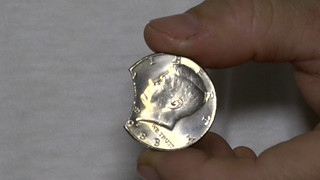 CONECA is devoted to helping numismatists wanting to know more about collecting coins with mistakes from the Mint. John Miller explains the goals of the organization and shows some great examples of error Lincoln cents including an off-center strike, a double strike, a struck die cap, and a saddle strike. He also shows a clipped planchet Kennedy 50 cent.
CONECA is devoted to helping numismatists wanting to know more about collecting coins with mistakes from the Mint. John Miller explains the goals of the organization and shows some great examples of error Lincoln cents including an off-center strike, a double strike, a struck die cap, and a saddle strike. He also shows a clipped planchet Kennedy 50 cent.
CONECA (pronounced: CO´NECA) is a national numismatic organization devoted to the education of error and variety coin collectors. CONECA focuses on many error and variety specialties, including doubled dies, Repunched mintmarks, multiple errors, clips, double strikes, off-metals and off-centers—just to name a few.
For more information, see:
https://conecaonline.org/
An excerpt of the video is available for viewing on the Coin Television YouTube Channel at:
https://youtu.be/iG3MLSaW2nQ
ANA'S 130TH ANNUAL ACCOMPLISHMENT AWARDS
Some familiar faces were recognized at the Annual Awards Banquet at this year's ANA World's Fair of Money. Here's the press release. Congratulations to all! -Editor
Numismatics is the study and collection of coins, paper money, tokens and medals, but at the American Numismatic Association (ANA) it is the people who truly define the hobby. Several individuals were recognized for their service and commitment to numismatics during the ANA's 130th Annual Awards Banquet and Member & Awards Celebration during the World's Fair of Money®.
The Elvira Clain-Stefanelli Memorial Award for Achievement in Numismatics honors women who have made significant contributions in the field. This year's recipient is Ellen Feingold, the curator of the National Numismatic Collection (NNC) at the Smithsonian Institution's National Museum of American History.
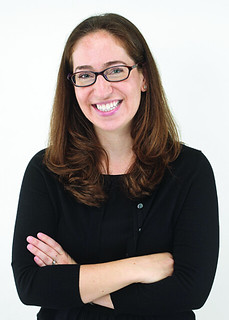 Feingold was first introduced to the history of money as a graduate student in economic and social history at the University of Oxford. A few months after she completed her doctorate in history, she says she was fortunate to be hired as a project curator in the British Museum's Coins and Medals Department, a position that greatly influenced her career path. "On my first day of work there, I knew I wanted to pursue a career in the field. I'm very grateful to the British Museum for giving me that rare early career training and exposure to such an amazing collection."
Feingold was first introduced to the history of money as a graduate student in economic and social history at the University of Oxford. A few months after she completed her doctorate in history, she says she was fortunate to be hired as a project curator in the British Museum's Coins and Medals Department, a position that greatly influenced her career path. "On my first day of work there, I knew I wanted to pursue a career in the field. I'm very grateful to the British Museum for giving me that rare early career training and exposure to such an amazing collection."
After moving with her husband to Washington, D.C., in 2013, she volunteered with the NNC and was hired as its curator six months later. In her current role, Feingold oversees a global collection of approximately 1.6 million objects that span more than 5,000 years.
As a historian interested in global history, Feingold loves that numismatics allows her to make connections between a wide range of places and periods. "As I open cabinets in the vault of the National Numismatic Collection, I often feel that I am traveling the world, and the objects always inspire new research questions and pathways I had not previously imagined pursuing." She has written two books, Colonial Justice and Decolonization in the High Court of Tanzania, 1920-1971 (2018) and The Value of Money (2015). Her articles on numismatics and history have been published in multiple journals, including Politico Magazine, Perspectives on History and Financial History.
Through her leadership, Feingold is able to contribute to numismatics and share the hobby with the millions of people who visit the museum. She has served as project director and curator or co-curator of several exhibitions. She is currently completing a long-term project to create a new gallery about money for children called "Really BIG Money." It will feature some of the largest monetary objects in the NNC and is designed to help elementary school students learn about money and economics. She says she "can't wait to open this new exhibition in 2022!"
Feingold adds that she is honored to receive this award. As a curatorial successor of Elvira Clain-Stefanelli, Feingold has a deep interest in Clain-Stefanelli's career at the Smithsonian and her contributions to numismatics. "I am very grateful to the ANA for recognizing my work with this award and for the ongoing support of the numismatics community since I became curator in 2014. I have learned a great deal from many of the ANA's members and look forward to continuing to learn from them and work together to raise awareness of our field."
Each year, the Association honors an Outstanding District Representative who sets the standard for promoting the hobby and ANA-member clubs throughout the country. This year's recipient, Robert Mellor, has also been recognized with the 2021 Lawrence J. Gentile Sr. Memorial Award for Outstanding Adult Advisor.
 Mellor has made countless contributions to the ANA and the hobby. He is passionate about sharing his experience and depth of knowledge with others and gives many presentations each year to both numismatic and non-numismatic organizations. A regular volunteer instructor on the topic of numismatics for an adult continuing education outreach program, he also conducts a monthly CoinTalk event at his local library and teaches a grading course for the ANA's Florence Schook School of Numismatics.
Mellor has made countless contributions to the ANA and the hobby. He is passionate about sharing his experience and depth of knowledge with others and gives many presentations each year to both numismatic and non-numismatic organizations. A regular volunteer instructor on the topic of numismatics for an adult continuing education outreach program, he also conducts a monthly CoinTalk event at his local library and teaches a grading course for the ANA's Florence Schook School of Numismatics.
An advanced hobbyist, Mellor focuses on grading, attributions, errors and numismatic items associated with early American history. He says, "If it was struck with a screw press, it interests me!"
Mellor's uncle, Charles V. Housman, was an avid coin collector who introduced him to the hobby when he was 8. Once bitten by the collecting bug, Mellor anxiously searched through the money he earned from his paper route for coins to fill his early blue Whitman folder albums.
After earning a bachelor's degree from the Florida Institute of Technology, he embarked on a career in the aerospace industry that has spanned over 35 years. He retired from Lockheed Martin in 2001 as a program launch director and currently supports launch operations for advanced programs within the Department of Defense.
Mellor is a life member of the ANA, an ANA district representative for Florida, an ANA certified exhibit judge and a member of the ANA Outreach Committee. In 2017 he was recognized with the ANA's Outstanding District Representative of the Year, an accolade the deserving hobbyist has earned once again. He holds memberships in multiple national and local clubs, including the South Brevard Coin Club, where he chairs its education committee. Mellor also volunteers his time with the Combined Organization of Numismatic Error Collectors of America (CONECA).
In an effort to recognize the most important collectors, scholars and hobby professionals of all time, the American Numismatic Association maintains the Numismatic Hall of Fame (HOF) at its Colorado Springs headquarters. ANA historian Jack W. Ogilvie proposed the Hall of Fame in the mid-1960s. By 1969 bylaws were drafted, and the HOF inducted its first honorees that same year. The next group was enshrined in 1970. with subsequent honorees inducted every two years. Today, individuals are recognized annually, with "modern" numismatists inducted in odd years, and "historic" personages in even years. This year, the HOF welcomes two familiar hobby luminaries – Barbara J. Gregory and the late D. Wayne ("Dick") Johnson.
Born in 1954 in Upstate New York, Barbara Gregory received a bachelor's degree in English from Alfred University in 1976, and later was employed as a typesetter and editor. Seeking new challenges, she set off for Colorado Springs, where she accepted a part-time editorial assistant position with The Numismatist in 1981. Seven years later, she became the first female editor-in-chief in the Association's history.
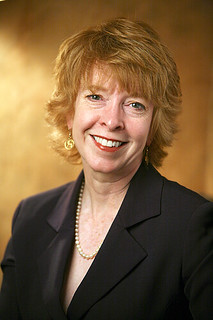 The Numismatist thrived under Gregory's leadership, transforming from a black-and-white digest to a full-color, award-winning magazine. In 2015 she surpassed Frank Duffield, who led the publication from 1915 to 1942, as the longest-serving ANA editor. Aside from educating and entertaining hobbyists, she felt her most important responsibility was supporting the membership. She gladly accepted articles from new writers and helped them look their best. With the change to the magazine's large format in 2003, she made the publication more personal by validating readers' interests and encouraging them to expand their hobby horizons.
The Numismatist thrived under Gregory's leadership, transforming from a black-and-white digest to a full-color, award-winning magazine. In 2015 she surpassed Frank Duffield, who led the publication from 1915 to 1942, as the longest-serving ANA editor. Aside from educating and entertaining hobbyists, she felt her most important responsibility was supporting the membership. She gladly accepted articles from new writers and helped them look their best. With the change to the magazine's large format in 2003, she made the publication more personal by validating readers' interests and encouraging them to expand their hobby horizons.
A fan of classic cinema, Gregory has assembled one of the largest and most complete collections of movie tokens. She has received the ANA's Edward C. Rochette Staff Service Award (2007); two Presidential Awards (1995, 2019); and two Heath Literary Awards (1992, 1996). Numismatic News named her a Numismatic Ambassador (2004); the Numismatic Literary Guild presented her its highest honor, the Clemy Award (2006); and the Central States Numismatic Society bestowed upon her its Sower Award (2020). A proud member of the Rittenhouse Society, Gregory remains active in numismatic publishing.
A respected and enthusiastic author and cataloger, Dick Johnson devoted his energy to the study of 20th-century American medallic art and technology. Born in Kansas City, Missouri, in 2930, he graduated from Rosedale High School and briefly attended Baker University in Baldwin before joining the U.S. Air Force in 1950. During the Korean War, he was assigned to the National Security Agency.
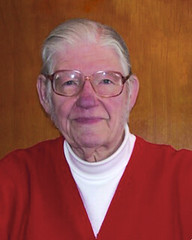 Johnson developed an interest in numismatics and in 1951 attended his first national coin convention, held in New York City. There, he and several other young collectors formed the Rittenhouse Society. He went on to co-found the Middle Atlantic Numismatic Association, and, along with numismatist Walter Breen, edited its publication. In 1954 he enrolled at Washington University in St. Louis, where he pursued a degree in business administration. While in school, Johnson was president of the St. Louis Numismatic Society and was appointed to the Central States Numismatic Society's board of directors. (In 1962 the latter awarded him its Medal of Merit.)
Johnson developed an interest in numismatics and in 1951 attended his first national coin convention, held in New York City. There, he and several other young collectors formed the Rittenhouse Society. He went on to co-found the Middle Atlantic Numismatic Association, and, along with numismatist Walter Breen, edited its publication. In 1954 he enrolled at Washington University in St. Louis, where he pursued a degree in business administration. While in school, Johnson was president of the St. Louis Numismatic Society and was appointed to the Central States Numismatic Society's board of directors. (In 1962 the latter awarded him its Medal of Merit.)
In 1960 Amos Press asked Johnson to help the Ohio publishing company start a weekly hobby newspaper, Coin World. He remained on staff for 18 months, not long after which he was hired as director of research for Medallic Art Company (MACO) in New York City. He cataloged its products, issued press releases, and edited the firm's newsletter, The Art Medallist.
Johnson was heavily involved in MACO's work for the 1976 American Bicentennial. The firm struck its first medal for the milestone celebration in 1972 and moved to a new facility in Danbury, Connecticut, in June of that year. After the event, MACO's sales dropped, production lagged and staff was cut, leading Johnson to purchase 64,000 medals from the company's stock.
That inventory was just what he needed to launch a medallic art dealership with fellow enthusiast Chris Jensen. The pair, doing business as Johnson & Jensen, conducted 27 successful auctions from 1978 to 1985, offering 27,000 lots of American art medals and related items to an eager collector base.
In 1987 Johnson became executive director of Collectors Auctions, Ltd., a position he held until 1990, when he retired from sales to write about the medallic art field. In 2012 he received the Carl Carlson Award for Cataloging from the Medal Collectors of America.
It's nice to see the Numismatic Hall of Fame recognition for Barbara and Dick, both longtime hardworking members of the numismatic community. Dick is greatly missed here at The E-Sylum, where he was a regular and enthusiastic contributor for years, with a consecutive contribution streak unlikely to be surpassed. -Editor
ADDITIONAL 130TH ANNUAL ANA AWARDS
Another ANA Press Release highlights four other award winners, including more familiar names to E-Sylum readers. -Editor
The American Numismatic Association (ANA) is honoring several numismatists who not only lead by example, but pave new avenues within the numismatic hobby. Recognized for their dedication, hard work, passion and contributions, these recipients will be acknowledged at the Chicago World's Fair of Money during the ANA Member & Celebration and the 130th Anniversary Awards Banquet.
Those being recognized are:
- Kellen Hoard for the Young Numismatist of the Year
- Kerry Wetterstrom for the Farran Zerbe Memorial Award for Distinguished Service
- David Vagi for Numismatist of the Year
- David Alexander for the Lifetime Achievement Award
The ANA recognizes that the future of the hobby depends on the recruitment and education of young numismatists. The Young Numismatist of the Year award honors young collectors for outstanding contributions to the hobby and industry. Receiving this year's award is Kellen Hoard, due to his devotion to the ANA and his outstanding hobby involvement.
 At just 17 years old, the Washington resident has already become a distinguished presence in the numismatic community. A practiced writer, Hoard is actively involved with the Numismatic Bibliomania Society and the Pacific Northwest Numismatic Association.
At just 17 years old, the Washington resident has already become a distinguished presence in the numismatic community. A practiced writer, Hoard is actively involved with the Numismatic Bibliomania Society and the Pacific Northwest Numismatic Association.
In 2019 the high schooler led the Summer Seminar Session 2 Young Numismatist Benefit Auction, which raised thousands of dollars for YN scholarships, and last year, he co-taught an ANA eLearning Academy course on how to keep young collectors engaged.
The astute teen effortlessly bridges the gab between collectors young and old, sharing hobby insight with those of all ages. "He is a voracious learner, outgoing with a wonderful, quick sense of humor and has a very kind spirit," says ANA Numismatic Educator Sam Gelberd. "YNs like Kellen are going to help secure the future of the hobby for many years to come."
Hoard will be recognized for his accomplishments at the Chicago World's Fair of Money during the ANA Member & Awards Celebration, Aug. 12 at 3 p.m.
Not only has the field of numismatics greatly impacted Kerry Wetterstrom, but the collector also has heavily influenced the hobby, which is why the ANA has conferred upon him its highest honor: the Farran Zerbe Memorial Award for Distinguished Service. Wetterstrom has been steeped in numismatics for nearly as long as he can remember, after his great aunt Bertha gifted him a Whitman folder for cents dated 1941-61.
Today, numismatics is Wetterstrom's career and avocation. Living in California, Canada and then Denver gave him access to a variety of coinage. At just 14, Wetterstrom purchased his first ancient coin from former dealer Tom McKenna and that same year, he decided to join the ANA.
"The ANA has had the greatest impact on my numismatic life," says Wetterstrom. "As soon as I was able to drive, I started visiting ANA headquarters." While there, he met Glenn Smedley, Ken Hallenbeck and (at the time) ANA Librarian Geneva Karlson, who answered his questions and helped guide him. In 1978 he attended his first ANA convention Houston.
During his high school senior year he founded a student club for coin and stamp collecting at John F. Kennedy High School. That summer, Wetterstrom received a scholarship from the Denver Area World Numismatists to attend the 1979 ANA Summer Seminar, where he met numismatist Q. David Bowers. It was Bowers's course "All About Coins" that convinced Wetterstrom he wanted to be in the coin business someday.
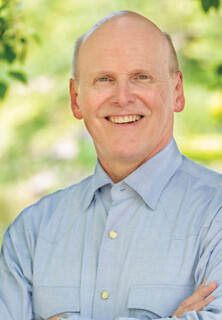 A few months after graduating high school, Bob Rhue, owner of Aurora Gold & Silver Exchange, hired Wetterstrom to work as a part-time sales clerk while he earned his bachelor's degree in mechanical engineering from the Colorado School of Mines. Rhue taught him how to grade coins.
A few months after graduating high school, Bob Rhue, owner of Aurora Gold & Silver Exchange, hired Wetterstrom to work as a part-time sales clerk while he earned his bachelor's degree in mechanical engineering from the Colorado School of Mines. Rhue taught him how to grade coins.
He worked with Rhue until 1987, when he accepted a position as auction director of Classical Numismatic Group, Inc. (CNG, then Classical Numismatic Auctions), a role that took him to the East coast and abroad. He lived in London in 1991 and after he returned to the States he edited a book about Parthian coinage.
Robert W. Hoge, ANA Museum curator at that time, contacted Wetterstrom and fellow collector David Vagi about teaching Hoge's ancients class at Summer Seminar. They accepted, making 1993 their first year as co-instructors. To this day, he dispenses his encyclopedic knowledge close to home and across the nation. He has traveled from the Atlantic to the Pacific, presenting numismatic talks in 12 states; he's lectured everywhere from school classrooms to civic association meetings.
By the end of the millennium, Wetterstrom purchased The Celator, a monthly magazine devoted to ancient and medieval coinage, from its founder Wayne G. Sayles in 1999. Over the next 13 years, he edited 156 consecutive issues of the printed publication. Under his management, it received multiple awards from the Numismatic Literary Guild. He bid adieu to his labor of love in 2012 and the following year, he returned to CNG as a senior numismatist, a position he still holds today.
The active collector is a fellow of the American Numismatic Society and the Royal Numismatic Society. He also belongs to the Pennsylvania Association of Numismatists, the Red Rose Coin Club of Lancaster and 16 other organizations, several of which he's served as president.
A few of his accolades include the Central Pennsylvania Numismatic Association's James Wagner Award (1994), Krause Publication's Numismatic Ambassador distinction (1998) and the Red Rose Coin Club's Paul Haleman Award (2000). Earlier this year, the New York International Numismatic Convention recognized Wetterstrom with its Richard Margolis Medal of Merit for his 20 years of contributions as the organization's chairman of education. He has also amassed several awards from the Association.
As an ANA club representative, he facilitates educational program in central Pennsylvania each year and is well-known on the convention circuit, as he's been an ANA exhibit judge since 1996. In addition to numerous journal articles, he's penned scripts for the ANA's Money Talks radio program and serves as contributing editor for The Numismatist. A guru of both world and local history, Wetterstrom volunteers weekly for the Lancaster County Historical Society. His numismatic expertise has been recognize nationally, as he has testified twice before the U.S. Department of State Cultural Property Advisory Committee regarding restrictions on the importation of numismatic material.
"One of the things I enjoy the most about the ancient coin market is how it truly is an international market," says Wetterstrom. "I have been able to travel to various countries over the years, where I have met many collectors and dealers, some of whom have become good friends. All of these experiences have helped expand my worldview, and I realize that a hobby like coin collecting unites people from different cultures, countries and backgrounds."
Wetterstrom will be recognized for his accomplishments during the ANA Member & Awards Celebration at the Chicago World's Fair of Money.
The Numismatist of the Year award, first presented in 1995, was established to recognize individuals who have demonstrated long-term leadership in the field and service to the Association. Their accomplishments should have a significant impact on the numismatic community. The 2021 Numismatist of the Year is David Vagi.
A lifelong numismatist, Vagi became fascinated with coins when he was 8 or 9. Although his parents supported his hobby, he says his interest was completely self-driven. He began studying ancient Greek and Roman coins in the 1980s. Taking instructor Robert Hoge's course on ancient coins at the 1985 ANA Summer Seminar sealed Vagi's fate as a professional numismatist. "From that week onward, I studied ancient coins academically and with purpose, converting my private fascination into something large and more promising," he said. "Without my involvement in the ANA, I likely would have taken a different path in life."
Vagi earned degrees in history and journalism from the University of Missouri-Columbia and studied at the University of Manchester (United Kingdom). He started his numismatic career in 1990 as a staff writer for Coin World and has worked in various capacities at Christie's, Superior Galleries, Spink America and R.M. Sythe. He opened and ran his own business, Delphi International Ancient Art, from 1996 to 2008.
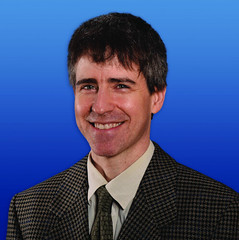 By far the most challenging and rewarding position of his career is his current one as director of NGC Ancients, which he's held since 2008. Vagi finds coins appealing because they make history tangible. He considers what it would be like to study the Roman Empire without any physical remains. "Without such proof, one might wonder if its rich history was entirely legend. Surviving objects, such as coins, bring the past to life."
By far the most challenging and rewarding position of his career is his current one as director of NGC Ancients, which he's held since 2008. Vagi finds coins appealing because they make history tangible. He considers what it would be like to study the Roman Empire without any physical remains. "Without such proof, one might wonder if its rich history was entirely legend. Surviving objects, such as coins, bring the past to life."
A prolific author, Vagi also brings coins to life for others through his writing. For more than 25 years, he has penned a column every month for a major numismatic publication, including Coin World, The Celator, Numismatic News, World Coin News and the Numismatist. His 1,294-page Coinage and History of the Roman Empire received multiple "book of the year" awards and is considered one of the leading references on the topic. Additionally, he is a contributing author to six other numismatic books and served as editor (1994-97) of SAN, the Journal of the Society for Ancient Numismatics. He also has written scripts for the National Public Radio program "Money Talks." His research and writing have earned him numerous accolades, including "Best Column" writing awards from the Numismatic Literary Guild, two ANA Presidential Awards and an ANA Heath Literary Award. He was also named one of Coin World's 100 Most Influential People in Numismatics, 1960-2020.
Vagi is a life member and fellow of the American Numismatic Society and a life member of the ANA, for which he has taught more than 20 weeklong courses on ancient coinage at Summer Seminars. Fans of the History Channel's Pawn Stars might have spotted him on the show – he has made frequent appearances as a resident coin expert since 2014.
Vagi says he appreciates receiving the ANA's Numismatist of the Year award "not only as a top honor, but because it's unusual for a recipient to be a specialist in ancient coins. I trust this reflects the rising profile of ancient coins within the numismatic community."
Vagi will be celebrated at the ANA's World's Fair of Money during the 130th Anniversary Awards Banquet, Aug. 13 at 7 p.m.
In honor of his extraordinary accomplishments in the field of numismatics, the ANA has bestowed its 2021 Lifetime Achievement Award on historian, writer and cataloger David Thomason Alexander. From museums to magazines, Alexander has maintained a vast record of professional involvement in the industry, and though he retired in 2013, his hobby activities have not slowed.
Alexander's career began when he was in his early 20s – in 1963 he secured a position as the director of the Historical Museum of Southern Florida (now known as the HistoryMiami Museum). For the next decade or so, when he wasn't at the museum, he could be found studying and preserving numismatic treasures recovered from the wrecks of Spanish galleons slumbering on the ocean floor off Florida's Atlantic coast.
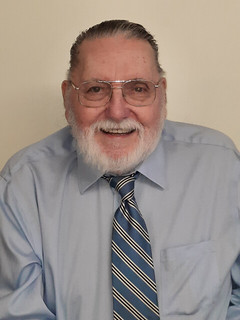 Whether at work or at play, Alexander's motivation has always been to engage others in the lore of history and numismatics. He accomplishes this through presentations and, more often, writing. In 1974 he joined the staff on Coin World and concurrently became the last executive editor of The Numismatic Scrapbook magazine. He developed a keen interest in historical and art medals and has written extensively on these topics, including two books: American Art Medals, 1909-1995: Circle of Friends of the Medallion and Society of Medalists (2010), published by the American Numismatic Society (ANS) and Medals of the Hall of Fame for Great Americans at New York University: An Under-utilized Resource in American
Medallic Art (2019), one of the first books electronically published by the Newman Numismatic Portal. (The former text received the Professional Numismatists Guild's Robert Friedberg Award in 2011.) In 1998 he founded the Medal Collectors of America, which has expanded into a robust group of dedicated scholars with its own journal and series of art medals.
Whether at work or at play, Alexander's motivation has always been to engage others in the lore of history and numismatics. He accomplishes this through presentations and, more often, writing. In 1974 he joined the staff on Coin World and concurrently became the last executive editor of The Numismatic Scrapbook magazine. He developed a keen interest in historical and art medals and has written extensively on these topics, including two books: American Art Medals, 1909-1995: Circle of Friends of the Medallion and Society of Medalists (2010), published by the American Numismatic Society (ANS) and Medals of the Hall of Fame for Great Americans at New York University: An Under-utilized Resource in American
Medallic Art (2019), one of the first books electronically published by the Newman Numismatic Portal. (The former text received the Professional Numismatists Guild's Robert Friedberg Award in 2011.) In 1998 he founded the Medal Collectors of America, which has expanded into a robust group of dedicated scholars with its own journal and series of art medals.
Alexander also has written profusely for Stack's Bowers Galleries, where he worked as a cataloger for 22 years. Prior to Stack's, he shared his cataloging skills with several other firms, including Johnson & Jensen, Kagin's, Numismatic Auctions of Florida and his own company, Alexander Numismatic Services.
Throughout these many pursuits, he has become a bit of a reference manual himself, and he is happy to share a page from his book with those eager to learn. In the late 1980s, he taught collecting basics classes at a community college in Miami and has served as an ANA Summer Seminar instructor several times. He's given a slew of audio-visual presentations at ANA conventions and as part of an ANS seminar series. There's no doubt that his participation in Toastmasters International with his wife, Pat, has played a role in helping him perfect his excellent presentation skills.
In addition to the ANA, the 81-year-old is a member of many other notable organizations. He is a charter member of the Florida United Numismatists (1955) and has served as editor of the American Israel Numismatic Association's publication, The Shekel (1981-82); executive director of the Numismatic Literary Guild (NLG, 1982-90); and president of the New York Numismatic Club (2005-06). He also has held several roles for the ANA, loaning both his expertise and his medals to the Association. He has served as a district delegate (1990), the ANA historian (1992-99), a member of the Education Committee (1993-95) and as the banquet chair of the 1997 New York City ANA Convention.
The adventurous collector's numismatic awards far outnumber his club memberships. His writing alone has earned him dozens of accolades, such as the Society for International Numismatics's Writer of the Year distinction (1963) and Silver Medal of Merit (1990), the NLG's Clemy Award (1987), the ANA's Wayte and Olga Raymond Memorial Literary Award for his article "Selling America's Rarest Coin: The 1933 Double Eagle" (2003), the Burnett Anderson Memorial Award for Excellence in Numismatic Writing (2010) and the Token and Medal Society's Silver Mishler Award for Numismatic Cataloging (2020). He was listed in Coin World's "Most Influential People in Numismatics, 1960-2020." Previously, the ANA has recognized him with the Glenn Smedley Memorial Award (1999), Medal of Merit (2000) and the Numismatist of the Year distinction (2013), along with four Presidential Awards.
Alexander will be celebrated during the 130th Anniversary Awards Banquet at the Chicago World's Fair of Money.
To read the earlier E-Sylum article, see:
WAYNE'S AUGUST 2021 ANA DIARY : Thursday Events
(https://www.coinbooks.org/v24/esylum_v24n33a20.html)
NOTES FROM E-SYLUM READERS: AUGUST 29, 2021
Macerated Currency Postcard
Carol Bastable writes:
"I am sure you have seen these macerated currency postcards before but what I liked about this one was the handwritten message. It says, "Just because you have a card made of $200 don't think you are rich". It is a numismatic message on this numismatic item and references the printed caption noting that the postcard is estimated to contain $200.00.
"While I have never studied these macerated postcards closely, I did think that this one has some rather large and colorful pulp. If I were a currency dealer or serious collector of paper money, I think I would be trying to see if any of the pulp was recognizable enough to identify a specific note. It would be kind of like looking for a needle in a haystack to line up a few letters or design with notes they may have come from. However, it would be very rewarding to get a match.
"To my surprise I saw that it was addressed to a person at a bank. The bank's name was abbreviated but it looks like Manufacturer's National Bank in Waterbury Connecticut. It also seems to be a related collectible for national bank note collectors. I had trouble deciphering the handwriting but it seems to be addressed to "... Bill Wolf at Manufacturer's National Bank Waterbury Connecticut."
Rare postally used postcard issued by J.F. Jarvis of Washington, D.C. during the late 19th century, postally used in 1906. These were made from bank notes redeemed and incinerated by the U.S. Treasury. Each is said to contain $200 in pulp money. Humorous note on the message side – please read for a chuckle. Card is in excellent condition.
To read the complete lot description, see:
1906 POSTCARD - MACERATED US CURRENCY BANK NOTE PULP FROM TREASURY WASHINGTON DC
(https://www.ebay.com/itm/1906-POSTCARD-MACERATED-US-CURRENCY-BANK-NOTE-PULP-FROM-TREASURY-WASHINGTON-DC-/133439247332)
I think our first mention of macerated money postcards was back in October 2020. Carol's example has a greenish tint - the earlier ones seemed brownish. Curious items of numismatic ephemera. -Editor
Carol adds:
"It is not quite as green as it appears in the photo. It is however more gray than the usual brown color ones."
To read the earlier E-Sylum article, see:
NUMISMATIC NUGGETS: OCTOBER 18, 2020 : Macerated Money Postcards
(https://www.coinbooks.org/v23/esylum_v23n42a26.html)
U.S. Cash in Afghanistan and Iraq
Kavan Ratnatunga writes:
"A video circulating on Social Media shows a huge hoard of US$100 notes in Afghanistan and was partly included in this video posted on YouTube by Hindustan Times."
To watch the video, see:
Watch: Taliban flaunt weapons, dollars after US, IMF freeze funds amidst Afghan turmoil
(https://www.youtube.com/watch?v=piPzfseZCoM)
Kavan adds:
"And this from the Iraq war."
To read the complete article, see:
How the US sent $12bn in cash to Iraq. And watched it vanish
(https://www.theguardian.com/world/2007/feb/08/usa.iraq1)
Thanks. Maybe we should send macerated currency next time... -Editor
1985 Operation Manna Commemorative Medal Sought
Danny Shelton writes:
"I'm writing to ask whether you could give me some pointers on locating an item. My grandfather flew in B-17s in WWII, and we recently learned one of his last missions was the combined US/UK/CA humanitarian airdrops over Holland at the end of the war, Operation Manna/Chowhound. I understand there was a commemorative coin minted in 1984/85 for an event in Holland celebrating the missions. You can find an example here: https://www.worthpoint.com/worthopedia/operation-manna-40th-anniversary-428150305
"As a part of our family history, identifying one for purchase would be of great sentimental value for my father and me. I would appreciate any advice you have."
Danny was referred to us by Shirley Johnson, who had found her late husband Dick's address on the Medal Collectors of America site.
The item is a 1985 medal commemorating the 40th anniversary of Operation Manna. Nice medal. Can anyone help locate one? -Editor
The Chase Manhattan Money Museum
Scott Barman writes:
"Reading the story about the Chase Manhattan Money Museum in the latest E-Sylum, I had to send along this reminisce:
Before my family moved out of the New York City area in 1974, my mother insisted that we take time to be tourists in our own hometown. During the winter and spring breaks, she would take us into Manhattan by train from Long Island to see the parts of the city most residents do not go.
After showing interest in coin collecting in 1970, our Spring 1971 trip was to the Chase Manhattan Money Museum. I was fascinated. My brothers did not care. Because they did not care, we could not stay all day. Unfortunately, I was never able to return before they closed.
Before leaving, my mother bought "The Story of Money" from the museum gift shop. I know I still have it packed in a box somewhere, but I remember that the cover had a "Money Tree." I believe they are Chinese coins connected to a tree structure. After years of my father telling me that money does not grow on trees, I had a picture that proved him wrong. For an 11-year-old kid, it was a brief moral victory at the beginning of a life-long hobby."
I could swear I had a copy of the publication Scott described, but I couldn't find one. But I did find the above little Chase Manhattan pamphlet with a smaller illustration of a Money Tree. Can anyone send us an image of the one with a Money Tree on the cover? Thanks. -Editor
To read the earlier E-Sylum article, see:
CHASE MANHATTAN MONEY MUSEUM INVENTORY
(https://www.coinbooks.org/v24/esylum_v24n34a04.html)
Muera Huerta Paper Money
Martin Bertelsen writes:
"Regarding the new Muera Huerta book - there is no information in the mention about paper money. I sold some a while ago. "
Thanks for the images! -Editor
To read the earlier E-Sylum article, see:
NEW BOOK: "MUERA HUERTA" COINAGE
(https://www.coinbooks.org/v24/esylum_v24n34a02.html)
Query: Ellis 83
Eric Hodge writes:
"I have a query your readers may be able to help with. On the NNP, Library, Archives, Eric P Newman Correspondence (Zander, Randolph), 1956-1973, on list 29 for February 1957, lot 110 (about page 88 of 175) there is listed a countermarked dollar reference Ellis 83. Does anyone know what Ellis 83 refers to please?"
I reached out to numismatic literature dealers Kolbe & Fanning. -Editor
David Fanning writes:
"The only Ellis who comes to mind is H Leslie Ellis, who wrote British Copper Tokens of the Straits Settlements and Malayan Archipelago,
but I don't see how that would be a fit here."
"H. Leslie Ellis? His "Valuable Collection of Coins and Tokens of the British Possessions and Colonies" was sold by Sotheby's in 1902."
I think that's a good candidate, as countermarks were used on coins in the British Possessions and Colonies. -Editor
However, David writes:
"Lot 83 in the Ellis sale does not appear to be illuminative of the query at hand..."
George asks:
"Are there any possibles listed in Manville?"
Thoughts, readers? -Editor
To read the documents on the Newman Numismatic Portal, see:
Catalogue of the valuable collection of coins and tokens of the British possessions and colonies, in gold, silver, copper &c., including many patterns and proofs, the property of Lieut. Colonel H. Leslie Ellis, ... who is relinquishing this series ... [06/18/1902]
(https://nnp.wustl.edu/library/auctionlots?AucCoId=511728&AuctionId=524354)
Randolph Zander Correspondence, 1956-1973
(https://nnp.wustl.edu/library/book/535397?page=87)
2026-Dated 1794 Type Dollar Proposed
Malcolm Johnson writes:
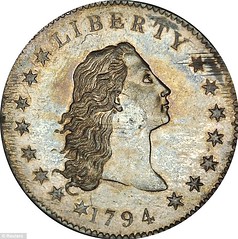 "I enjoyed Mr. Pearson's ideas for special coinage and currency in 2026. Although I agree it is
unlikely much will be done with our currency (of course stamps are easy to use as commemorative
subjects) but I would like to add to Mr. Pearson's coinage ideas with one of my own. How about a
special set of America's first coins in silver and clad for collectors. It would be wonderful to
own a 1794 type dollar with a 2026 date, etc. "
"I enjoyed Mr. Pearson's ideas for special coinage and currency in 2026. Although I agree it is
unlikely much will be done with our currency (of course stamps are easy to use as commemorative
subjects) but I would like to add to Mr. Pearson's coinage ideas with one of my own. How about a
special set of America's first coins in silver and clad for collectors. It would be wonderful to
own a 1794 type dollar with a 2026 date, etc. "
Interesting idea, and follows in the footsteps of the 2021-dated Morgan and Peace dollar coins. Better in line with the semiquincentennial theme might be the 1776-dated "Continental Dollar". THAT could get interesting... -Editor
To read the earlier E-Sylum article, see:
2026 INDEPENDENCE COMMEMORATIVE IDEAS
(https://www.coinbooks.org/v24/esylum_v24n34a14.html)
More Stomach Coin Finds
David Powell writes:
"The late Robert Thompson, expert on the British 17th century token series, told me that the most bizarre and distant known find in his series was that of a farthing of Richard Langley of Ramsgate {Williamson 452}, dated 1657, found in the stomach of a five-foot shark caught off Galveston, Texas, in 1931. It was reported in the Morning Post of 9 September 1931, p.13, col.1, followed by a letter on 12 September from A. J. Wood of Canterbury, but unfortunately the online British Newspaper Archive currently only contains the Morning Post up to 1909.
"On the same subject, the Numismatic Chronicle reported this newspaper extract from the Irish Times in 1922:"
This is not our first bovine numismatist. See the earlier article from February 2004. -Editor
To read the earlier E-Sylum articles, see:
BOVINE BANKING
(https://www.coinbooks.org/esylum_v07n06a18.html)
STOMACH COIN FINDS
(https://www.coinbooks.org/v24/esylum_v24n34a12.html)
The Negotiable Cow
David adds:
"Readers may also be interested in the novelist A.P.Herbert's story about the man who tried to pay his annual tax bill by writing a cheque on the side of a cow and presenting it for payment.
The Negotiable Cow
, as the story is also known, is the most famous of a whole series of humorous stories, mainly written in the 1920s and 1930s, which generally mock the legal system. I saw it when it was televised in 1967 but I am not sure that it has been back on since."
This never came up in our conversations, but my old friend "Money Artist" J.S.G. Boggs would have enjoyed this. -Editor
For more information, see:
Board of Inland Revenue v Haddock
(https://en.wikipedia.org/wiki/Board_of_Inland_Revenue_v_Haddock)
The Negotiable Cow (1967)
(https://www.imdb.com/title/tt0866894/mediaviewer/rm4290806785/)
2021 WORLD'S FAIR OF MONEY: JOHN BRUSH
Here are some additional perspectives on the hobby and market in the wake of the recent American Numismatic Association's World's Fair of Money. First, here's what John Brush of David Lawrence Rare Coins wrote in an August 19, 2021 blog. -Editor
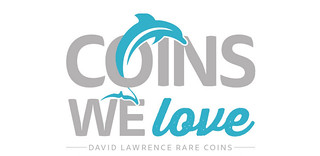 I always find that the major shows feel a lot different in hindsight than they do in the middle of the chaos. This week was no different. In this year's event, we set up one of the more elaborate coin displays that we've ever done and it was truly a hit. We had hundreds of folks who came by and enjoyed viewing some of the coins from the D.L. Hansen Collection. Even better, a large percentage of folks who looked at coins in our cases returned to purchase them.
I always find that the major shows feel a lot different in hindsight than they do in the middle of the chaos. This week was no different. In this year's event, we set up one of the more elaborate coin displays that we've ever done and it was truly a hit. We had hundreds of folks who came by and enjoyed viewing some of the coins from the D.L. Hansen Collection. Even better, a large percentage of folks who looked at coins in our cases returned to purchase them.
Now if you heard through the grapevine that the show was fantastic, you might have been just a little misled. The show had wider aisles than in the past which made it seem to spread out for miles leading to less crowded walkways and less of a real buzz in the venue. Yes, the show was an "A" when it comes to wholesale trading among dealers. In fact, dealers were so actively pursuing coins that most of them avoided the concession stand (maybe that was because of the hot dogs though?). In truth, dealers were swarming around the floor both buying and selling. However, for the show to be an "A+", the collecting public must be involved. While the collectors that showed were certainly there to buy coins (and we were thrilled to see them!), the overall attendance was rather poor. The stats may seem to prove this statement wrong, but when using the eye test
, it was clear that the public attendance was underwhelming. Now I'm sure the pandemic plays a large part in that, but I'll continue to say that the location of Rosemont played further into it. Unfortunately it's not a location for families or developing collectors. The restaurants, hotels, and shopping mall are nice, but it's just not a destination.
I would typically say that this lack of collectors shows that the market is not as hot as it was in the previous months…but, that would be incorrect this time. The internet's impact on the hobby cannot be understated. This year the live auctions for the ANA show were delayed a week to allow for the auctions to be hosted from the respective offices. I don't believe this bodes well for future coin show promoters, but the delay allowed for dealers (and collectors) to lick their wounds from the show and come back a little stronger the following week. And boy did that happen! There were four major rarities being offered between the two auction companies, of which we were pursuing each for the D.L. Hansen Collection. Turns out we were incredibly unsuccessful. The key pieces that we were hoping to obtain, the 1861 Paquet $20 PCGS/CAC MS67 brought stronger money than we could imagine. And that wasn't the only piece that brought strong pricing. Across the board, the attractive, original pieces with eye appeal brought incredible sums. Even some unattractive pieces brought record prices! I don't quite understand that, but it just shows the strength of the coin market right now. While we weren't successful on any of the real trophy coins, we did grab a few pieces that we had our eyes on. In the end, it was disappointing from a bidding standpoint, but incredibly encouraging when you think about the value of coins and how it has financially enhanced the holdings of so many collectors.
Overall, we really thought that things might slow down after the ANA show, but the early returns are proving that exactly wrong. Hopefully the trend continues and we'll still be running across some large bourse floors in the near future and meeting new folks that are finding their way to the hobby.
To read the complete article, see:
Coins We Love: World's Fair of Money Recap
(https://blog.davidlawrence.com/coins-we-love-worlds-fair-of-money-recap/)
2021 WORLD'S FAIR OF MONEY: IAN RUSSELL
Some of the headline coins hammered to a mystery buyer represented by Ian Russell of GreatCollections. From the press release. -Editor
Three of the world's most valuable rare coins were acquired within a 24-hour time span, in two different auction locations, by Ian Russell, president of GreatCollections Coin Auctions (www.GreatCollections.com) of Irvine, California. The three numismatic treasures were purchased for a combined total of $21.5 million on behalf of collectors, and now two of those coins may be exhibited alongside the fabled 1933 Double Eagle, also acquired by a GreatCollections client for a record-smashing $18.9 million earlier this year.
I was able to bid in person on the 1794 and 1804 dollars and an 1861 Paquet Double Eagle, along with several other important coins at two different auctions for a combined total of $24 million in winning bids. That's even after my original flight from California to Texas was canceled. It is extremely fulfilling to help collectors with their passion, as it's my passion as well,
explained Russell.
Russell was the top bidder for the top three most valuable coins sold in conjunction with the American Numismatic Association's 2021 World's Fair of Money® by Stack's Bowers Galleries on August 17 in Costa Mesa, California and Heritage Auctions on August 18 in Dallas, Texas. They are:
- 1804 Class I Original Draped Bust dollar, PCGS Proof-68, from Stack's Bowers, the finest known of its kind. It was presented as a diplomatic gift on behalf of President Andrew Jackson to the Sultan of Muscat in 1835 and most recently was in the Pogue family collection. Winning bid: $7,680,000, making it the fifth most valuable U.S. coin ever sold.
- 1861 Paquet Reverse Double Eagle, PCGS MS-67 with CAC approval, from Heritage, the finer of only two known examples and formerly in the collections of Virgil Brand, King Farouk of Egypt, and Ambassador & Mrs. R. Henry Norweb, among others. Winning bid: $7,200,000 is the sixth highest price ever for a U.S. coin.
- 1794 Flowing Hair dollar, PCGS MS-66+ with CAC approval, also sold by Heritage and previously in the collections of Lord St. Oswald, Jimmy Hayes, D. Brent Pogue, and Bob R. Simpson, among others. Winning bid: $6,600,000 is the highest price ever paid at auction for a Mint State 1794 dollar.
While we have managed to broker many rarities quietly in private transactions over the years, it was quite a coincidence that three of the major rarities we hoped to acquire were auctioned in a 24-hour period,
said Russell. For the 1794 dollar, we represented a serious collector with a long history in coins. For the 1804 dollar, we represented a relatively new client to GreatCollections who contacted us after reading about the 1933 Saint-Gaudens Double Eagle. We also acquired two rare gold patterns for a 45+ year veteran collector who recognized the ‘once in a lifetime
' opportunity to add them to his collection, explained Russell.
Russell exhibited the 1933 Double Eagle at the recent 2021 Chicago World's Fair of Money. He said the exposure gained from that display introduced a new group of collectors to GreatCollections over the past month.
‘We are discussing with the new owners of the 1804 and 1794 dollars about displaying the pair at an upcoming coin show so that other collectors can see them in person. Perhaps we'll even be able to display the 1933 Saint again. It would be a ‘mic drop' presentation to have three of the most famous U.S. rarities on display at a single show, he said.
To read the complete article, see:
$24 Million in 24 Hours: GreatCollections Top Bidder for Three Historic Rare Coins
(https://www.greatcollections.com/kb/24-Million-in-24-Hours-GreatCollections-Top-Bidder-for-Three-Historic-Rare-Coins-t424-4.html)
THE BOOK BAZARRE
2021 WORLD'S FAIR OF MONEY: HARRY LAIBSTAIN
E-Sylum supporter Harry Laibstain had these post-show observations in an August 26, 2021 email to clients. -Editor
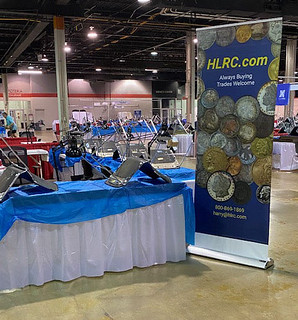 Because of the pandemic our personal and business experience has changed profoundly. While the coin business prospered during Covid, there have been many new experiences. The auction companies, like the grading companies, have decided it's cheaper and more efficient to keep staff at home. As long as anyone can recall, auctions were conducted during the show starting either Tuesday or Wednesday. This always presented a crush of responsibility just as you're getting into the groove of the show. If you had lots to view and bids to figure in the early sessions, you were likely stressed out. Trying to rush this activity leads to mistakes which leads to more stress. This year I didn't even try to accomplish my auction assignments until Friday morning. Frankly, it was glorious not to need to get that done while managing the show. When I did arrive at viewing the boxes were available and my lot shower was focused on me and only me. The experience was a welcome relief and another reason the show was so successful.
Because of the pandemic our personal and business experience has changed profoundly. While the coin business prospered during Covid, there have been many new experiences. The auction companies, like the grading companies, have decided it's cheaper and more efficient to keep staff at home. As long as anyone can recall, auctions were conducted during the show starting either Tuesday or Wednesday. This always presented a crush of responsibility just as you're getting into the groove of the show. If you had lots to view and bids to figure in the early sessions, you were likely stressed out. Trying to rush this activity leads to mistakes which leads to more stress. This year I didn't even try to accomplish my auction assignments until Friday morning. Frankly, it was glorious not to need to get that done while managing the show. When I did arrive at viewing the boxes were available and my lot shower was focused on me and only me. The experience was a welcome relief and another reason the show was so successful.
After viewing I had to stop by the Stacks Bowers table because the 1804 Dollar was at their bourse location. Luckily, their friendly president Brian Kendrella was there and got the coin for me to view. While I looked at this stunning historic multimillion dollar coin we chatted about the auction strategy at shows going forward. Brian confirmed they would not be holding auctions at shows for the foreseeable future. They have their own high tech studio in Costa Mesa. He seemed very relaxed and happy about this decision. It's not easy to move your entire business across the country and run it smoothly. A little known fact about president Kendrella: he was a summer intern at Stacks Bowers as a teenager. His education led him to investment banking and then Stacks Bowers came calling. Did he know he would one day be their president? He is a young man and if you haven't met him I encourage you to introduce yourself at a show. He is easy-going and highly approachable.
There were a lot of cool coins at the show. In addition to the 1804 dollar I was fortunate to view the 1794 dollar in 66 plus as well as the 1861-P Paquet $20 among others. These coins brought a combined 24 million dollars. There was a time not so long ago if a coin broke a million dollars it was a big deal. All of a sudden five million is not unheard of and up to ten million is happening with some degree of regularity. In many ways the coin market we had before the pandemic has come out on the other side as something completely new. While Heritage and Stacks Bowers remain constant with tried and true well known numismatists running them, the industry is going through some big changes. Perhaps the most interesting to me is big time corporate ownership of the two major grading houses.
At the beginning of the year, an investment group led by Nat Turner, a well know sports card collector himself, took PCGS private at a price tag reported to be in excess of 850 million dollars. Recently Blackrock investment group assumed a controlling interest in NGC's parent company for 500 million dollars. So much for the cottage industry we grew up in. We are only just beginning to see small policy and personal changes at the grading companies with much more expected. PCGS has selected a new interim President, Stephanie Sabin. I had a chance to speak with her at the show. She is a smart, experienced and ambitious. She was unabashed in telling me she would like to have the job permanently. She has been with PCGS for 15 years and her father also works for the company. Most recently she functioned as the chief of staff under the outgoing president Brett Charville. From what I could glean about her from our conversation and what I know from friends at the company she would be a great president.
We can expect a lot of changes in the near future. My friend and fellow coin dealer John Agre of Coin Rarities Online was once a corporate man. When I have questions of this nature he always has an astute perspective. He tells me it's not unusual to see a series of spin-offs, acquisitions and staff changes in these buyout situations. What you see now will be very different in the future. The new guard has a responsibility to preserve and grow the business. It's uncanny how obvious it is once explained. Though we in the coin business would like to think these parent companies revolve around numismatics, it's also clear that isn't necessarily so. I didn't know until recently that sports cards are the leading revenue generator for collectors universe. With the money these investment groups have laid out one has to believe our industry will go completely mainstream. Significant growth seems inevitable. I am not well versed in the future plans of the Nat Turner Group and Blackrock but I am certain they have a plan and we will all be privy to it soon.
I became an authorized dealer at PCGS during the first year they were operating. I was dealer #115 at the time and a virtual neophyte to the coin business. Six years of trading raw coins had prepared me for what was to come but I had no idea how it would propel my career. Because I adapted quickly to certified coins I was able to move up the food chain and grow my business more rapidly then those who resisted. When I had a good show or made a big deal I would credit the power of plastic for giving me that opportunity. I believe a sea of change as large as the creation of PCGS in 1986 followed by NGC in 1987 is about to take place.
The hot market we are experiencing is likely a harbinger of what's coming. I think this is a very good time to be in coins. Change is good and leads to opportunity. With that in mind and remembering my journey I'd like to close by saying this. Good luck to all the young dealers and new collectors making their way now. This is your chance to get a jump on the prior generations who will be undone by these changes. Grab a chair, (but not mine), a place at the table awaits you.
To visit their website, see:
http://hlrc.com/
I'll second Harry's suggestion. An old song has been popping up in my Spotify rotation lately, and the sentiment is apt: "... you better start swimmin' or you'll sink like a stone; For the times they are a-changin'" -Editor
PRINCETON UNIVERSITY'S FLAME DATABASE
Princeton's FLAME database project has passed a new milestone and rolled out a new circulation module to track coin movement. Here's the press release. -Editor
 In July 2021, the Framing the Late Antique and Early Medieval Economy (FLAME) project passed the major milestone of digitizing, storing, and visualizing the production and movement of more than 700,000 coins across Western Afro-Eurasia.
In July 2021, the Framing the Late Antique and Early Medieval Economy (FLAME) project passed the major milestone of digitizing, storing, and visualizing the production and movement of more than 700,000 coins across Western Afro-Eurasia.
FLAME is a Princeton University-based project that supplies hard data about the early medieval economy over about 400 years (from 325 to 750 CE). It is head-quartered in Princeton University Library's Special Collections, where it is run by FLAME Chair and Princeton's Curator of Numismatics Alan Stahl and Database Coordinator Mark Pyzyk. Recently, FLAME launched its second major web application—the Circulation Module—designed to track coin movement across a region stretching from Portugal to India. The application stores information on hundreds of thousands of coins, including where they were minted, as well as where they traveled.
Over the last five years, a collaborative team of 35 international scholars has produced a large and growing body of data. With this unprecedented body of evidence, stored in and accessible through a single web application, FLAME contributes to scholarly understanding of phenomena as diverse as the fall of the western Roman empire, the consolidation of the Byzantine empire, and the rise of Islam. Understanding these better is key to improving accounts of the origins of the modern economy.
Moving forward, FLAME will continue to build on this powerful data and mapping tool to reshape scholarship on the late antique to medieval transition. Through forthcoming publications, collaborative projects, and further FLAME development, we hope to better show the full scope of economic change at this critical juncture in history.
To read the complete article, see:
Over 400 years of coins digitized and visualized in Princeton University's FLAME database
(https://library.princeton.edu/news/general/2021-08-16/over-400-years-coins-digitized-and-visualized-princeton-university%E2%80%99s-flame)
To access FLAME, see:
https://coinage.princeton.edu/
To read the earlier E-Sylum article, see:
FRAMING THE LATE ANTIQUE AND EARLY MEDIEVAL ECONOMY
(https://www.coinbooks.org/esylum_v19n15a20.html)
VOCABULARY TERM: FINGERPRINT TECHNOLOGY
Here's another entry from Dick Johnson's Encyclopedia of Coin and Medal Terminology, about the disappearing use of hands-on work in creating coins. -Editor
Fingerprint Technology. Hand work in which cutting, carving, shaping is all accomplished by hand in contrast to mechanical (or computer) controlled manufacture. The handwork can be considered the hand crafting, and the leaving of fingerprints on the item, hence the term. For most of the history of coin and medal manufacture it was accomplished by handworking patterns, dies, tools and presses. Even when the die-engraving pantograph came into widespread use (with mechanically controlled milling of the design) there was still handwork required to put these dies into production.
At the end of the 20th century where laser cutting is in the offering, and computers are programmed to control much of the mechanical work, less fingerprint technology is required. Perhaps in the future such handwork technology will become entirely obsolete.
To read the complete entry on the Newman Numismatic Portal, see:
Fingerprint Technology
(https://nnp.wustl.edu/library/dictionarydetail/515912)
WALDO NEWCOMER (1867-1934)
American Numismatic Biographies author Pete Smith submitted this vignette of super-collector Waldo Newcomer. Thanks! -Editor
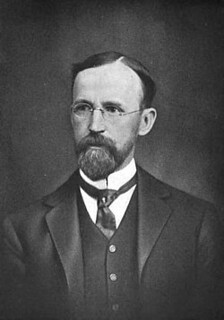 Newcomer, Waldo (Charles) Collector (b. 9/14/1867 d. 6/29/1934)
Newcomer, Waldo (Charles) Collector (b. 9/14/1867 d. 6/29/1934)
Born in Baltimore, Maryland. He was in poor health as a child and was home schooled. Graduated with A.B. from Johns Hopkins in 1889. Married Margaret Vanderpoel October 7, 1897. They had three children. Employed as a clerk with Baltimore Storage & Lighterage, later Atlantic Transport and became secretary of the company in 1894. He resigned in 1901 to join the Safe Deposit & Trust Co., later treasurer of the Atlantic Coast Line Railroad.
Newcomer was president of the National Exchange Bank 1906 to 1924. In 1924 became chairman of the board of Atlantic Exchange Bank & Trust Co. and later Baltimore Trust Co. CEO of Baltimore Trust Company March 1929 to January 1933. He was vice president of the Atlantic Coast Line Co and Northern Central Railroad and served on the board of many corporations and institutions.
He was a benefactor of many local charities and was treasurer of the Maryland School for the Blind and the Mercantile Library.
The Newcomer collection suffered from a burglary in 1913. Various estimates of value were published but it was around $30,000. A burglar alarm had been installed shortly before the theft. One of the electricians, Frederick Holtz, rented a safety deposit box and paid for the box with a $50 California Territorial gold coin. The manager of safe deposit boxes, Stanley Walker, showed the coin to S. H. Chapman who recognized it as a coin he had sold to Newcomer. The coin was traced back to the electrician who was arrested. It was reported that about 1250 pieces were taken. Only 151 pieces were recovered from the safe deposit box but they represented 60% of the value of the collection. Holtz had difficulty disposing of the silver coins so he dumped $2,442 in face value into the Hudson River off Weehawken. At the time of his arrest Holtz was penniless and had to borrow an overcoat to protect himself on the trip back to Baltimore.
At the 1916 ANA convention he exhibited some of his collection including private gold. He showed his 1804 dollar and Gobrecht Dollars. He bought the Granberg collection and Heaton collection. In 1917 he sold about $20,000 worth of duplicates to B. Max Mehl.
His collection has been described as the greatest coin collection never to have appeared at auction. The Newcomer collection was sold to B. Max Mehl during the Depression in October 1931 for $250,000. The collection included an 1804 dollar sold to Colonel Green. He had the Trade Dollars of 1884 and 1885. He had an 1853 half without rays or arrows. There were 130 different Half Eagles including an 1854-S. His $3.00 and $2.50 gold sets were complete. He had 75 varieties of Massachusetts silver coins. One of his two Brasher Doubloons sold to Colonel Green. These were just part of his extensive run of private and territorial gold. He had 120 encased postage stamps. Mehl sold off the collection at fixed prices.
The Newcomer pattern collection was sold at auction by J. C. Morganthau.
He died in Honolulu and is buried at Woodlawn Cemetery in Baltimore.
HARVEY STACK'S NUMISMATIC FAMILY, PART 103
The latest article in Harvey Stack's blog series begins a look at 1988, a key year of transition of the hobby in the United States. -Editor
Looking forward to 1988, we did not anticipate the changes that were before us, as several happenings took place a few months before the New Year, and other events occurred after the year started.
The numismatic market had its ups and downs starting in late October right into the new year 1988, yet the drop in value related more to the modern issues which depended on the values of precious metals. Interest also decreased in the newer U.S. Mint products, as well as items from many newer series.
Collectors who were focused on more classical issues struck prior to the Second World War, found that these either retained their value or dropped only a bit. These collectors generally bought coins because they enjoyed owning them and therefore often chose not to put them up for sale in a declining market. In times where it was difficult to sell, they retained their coins for a better day.
Stack's had a dozen sales during 1988, including the renowned large cent collection of Herman Halpern, the Frank Sprinkle Collection of U.S. Gold and Silver Coins, the Herbert Oechsner Collection of Colonials, selections from the Gilbert Steinberg Collection, a New England Museum Collection, and the Charles Kramer Collection of Rare U.S. Gold, as well as a number of specialized collections. These consignments came primarily from collectors that we had worked with for decades, helping them to acquire what they needed for their collections. Some collectors did choose to sell, while other consignments were from estates or their families. Many came to us as a way of thanking us for working with them. We, of course, were thrilled to be remembered.
As it had in previous years, the ongoing attempt to standardize the grading of coins continued to have a strong effect both on collectors and the hobby. After World War II, growth in collecting and the large influx of new people meant that it was easier to take advantage of those who had little knowledge. This resulted in a great deal of counterfeiting and doctoring of coins, as well as using grading to con
those who didn't know any better. Over the decades the government as well as the ANA and other hobby groups had worked to improve this situation and had made strides in that direction. With authentication services, grading standards and, eventually, third-party grading, things in the hobby had improved, although there were always people who found ways to work around these efforts.
By 1988, both PCGS and NGC were up and running, and they were attracting more and more submissions all the time. ANACS (the grading service of the American Numismatic Association) was also grading coins. People could feel more confident about the items they were buying. As noted, there was abuse of this system as well, with people cracking out their coins and resubmitting them in hopes of getting a higher grade, and thus increasing the value of their pieces. Even with this supposed objective
grading, those of us at Stack's still played an important role as professional numismatists, as we had the ability to look beyond just the grade on the holder and offer opinions on the other factors that made a coin desirable or not. Overall, the addition of third-party grading would be a big help to the industry, although there were problems that arose over the years.
There were other areas of the hobby where buyers and sellers, especially new or uninformed collectors could be taken advantage of.
Due to an Act of Congress in 1985, the Mint started to make and sell gold and and silver coins in 1986 (with face values far below the precious metal value of each coin
). They gave the gold eagle a weight of one ounce of gold, with a face value of $50, when the gold value was more than $360 at the time. The one-ounce silver eagle had a face value of $1, although the metal was worth about $10. There was no clear information about why the Mint decided to do this as it could be confusing to those who were buying the items.
The Mint offered these eagles to the public at a premium above face value, advertising the coins
as an investment in the future.
They were marketed through some dozen distributors, who also made a profit on their original cost.
The face value/precious metal value was not clear to everyone in the marketplace, but the fact that the Mint was involved in the selling gave confidence to those who were making purchases. This created an opportunity for unscrupulous people to use this confusion in the market to add to their own bottom line.
In addition, many counterfeits hit the marketplace, both from here as well as from overseas. False "plastic holders" were used that featured inflated grades that artificially raised the value of the item in the container. Smaller dealers and Mom and Pop
shops bore the brunt of the damage from these scams. Doctored, improperly marked coins flooded the market, promoters used large ads in local papers to sell investment opportunities,
even using the sales pitches of the United States Mint. This caused great concern to the average public buyer and to those of us who made our living in the business.
All the above led to some destabilization of the market and drew in the Secret Service (Treasury Agents), the Federal Trade Commission (FTC) and the Security Exchange Commission, (SEC). Each of these agencies had only small staffs to attack the problem. The FTC did have some agents who successfully stopped some of the activity but needed more direction from their director to stop these offenses. In 1988 and on into the next year 1989 the Director of the FTC challenged our industry in order to try to put in place rules and regulations to address these problems.
The numismatic market had some real "bumps" to overcome during these times that will be further discussed in my next story about Numismatic Growing up in 1989.
To read the complete article, see:
Harvey Stack Remembers Growing up in a Numismatic Family Part 103
(https://www.stacksbowers.com/News/Pages/Blogs.aspx?ArticleID=harvey-stack-remembers-numismatic-family-part-103)
To read the earlier E-Sylum article, see:
HARVEY STACK'S NUMISMATIC FAMILY, PART 102
(https://www.coinbooks.org/v24/esylum_v24n33a17.html)
STEPHEN ALBUM JUNE 2021 E-AUCTION 11 RESULTS
Here's the results press release for the Stephen Album Rare Coins Internet Auction 11. Nice mix of world material, bringing great prices. -Editor
Stephen Album Rare Coins held its Internet Auction 11 on August 16, 2021 at its offices in Santa Rosa, CA. The auction vastly exceeded all expectations, with a total hammer price of $120,588 (including buyer's fees) on a middle estimate of $43,500 for 500 lots of PCGS-certified coins, and a sell-through rate of just under 97%. A number of price records were broken (based on auction records of coins in the same certified grade), further attesting to the strength of the currently soaring coin market.
Many items went for multiples of their estimates, including the following (prices include buyer's fees):
LOT 447: CHINA: SINKIANG: Republic, silver sar (tael), Dihwa (Urumqi), year 7 (1918), Y-45.2, L&M-839, superb bold strike, much original luster, cleaned, PCGS graded UNC details. Estimated at $500-700. Realized $5,100.
LOT 486: BRITISH INDIA: Victoria, Queen, 1837-1876, silver 2 annas, 1875(b), KM-469, S&W- 5.41, Prid-517, a lovely toned example! PCGS graded MS63. Estimated at $100-150. Realized $3,900.
LOT 99: EGYPT: Fuad I, as King, 1922-1936, silver 5 piastres, 1923/AH1341, KM-336, a lovely lightly toned example! PCGS graded MS64. Struck at the Heaton mint, Birmingham. Estimated at $50-75. Realized $3,120.
LOT 163: GREAT BRITAIN: silver trade dollar, 1929-B, KM-T5, Prid-26, a lovely example! PCGS graded MS63. Estimated at $200-300. Realized $1,020.
LOT 49: CYPRUS: George V, 1910-1936, AE piastre, 1927, KM-18, a superb quality example! PCGS graded MS64 BN. Estimated at $75-100. Realized $1,020.
LOT 296: PANAMA: Republic, silver 1/4 balboa, 1934, KM-11, a wonderful quality example! PCGS graded MS64. Estimated at $50-75. Realized $840.
Company founder Steve Album noted Some items went for shocking prices. The market is very
strong right now. Whether it is a premier auction or an internet auction, the buyers seem to be
finding everything and providing strong competition for these items.
The firm is currently taking consignments for future internet and signature auctions. Please visit www.stevealbum.com for more information.
GERRY FORTIN LIBERTY SEATED QUARTER RESULTS
Circulated U.S. coins are seeing market attention as well. Here's a press release from Gerry Fortin Rare Coins about recent Liberty Seated Quarter sales. -Editor
Collector Grade Liberty Seated Quarters Shine in GFRC Online Auctions
While the post-ANA convention auctions featured any number of multi-million dollar rarities such as the
Childs-Pogue 1804 dollar, which realized $7.68 million, or the Simpson 1794 dollar ($6.6 million),
collector-grade material is also drawing exceptional interest among Liberty Seated set builders. Struck in
widely varying quantities from 1836 to 1891, the Liberty Seated series presents a number of challenges
to collectors building date and mintmark sets of these 19th century economic workhorses. The dime,
quarter, and half dollar series are particularly extensive, with Guide Book sets consisting of over a
hundred examples. Many of these are lower mintage issues that do not trade at significant premiums
over type coin
prices, making the Liberty Seated series especially attractive for fans of rarity.
Following the trend of the overall numismatic market, eye appeal has become more of a determinant of value in recent years, especially with the advent of the Certified Acceptance Corporation (CAC), which certifies PCGS or NGC-slabbed coins as premium for the grade. Collectors and dealers are noticing higher prices for CAC-certified examples, and published price guides for CAC-approved coins fulfill demand for the latest market data. This is especially important for Liberty Seated coinage, small change which generally saw extensive circulation. Many survivors are lower grade or exhibit surface problems such as scratches or environmental damage.
As a result, the Liberty Seated coinage market is beginning to exhibit bifurcation, with exceptional pieces drawing increasingly strong premiums. A recent sale of CAC-approved Liberty Seated quarters, featuring the Tenafly Collection and conducted by GFRC Auctions is illustrative. This sale, which closed on August 28, included a nearly complete set of CAC-certified, collector grade Liberty Seated quarters with an average grade in the EF40 range. A noteworthy example was a CAC-approved 1867-S quarter graded VF20 by PCGS, which sold for $3,250, vs. a CDN CAC valuation of $1,800. The appeal of this example is obvious, with smooth, coin-grey surfaces and even, natural toning. While PCGS has certified 87 pieces in all grades, CAC has approved only ten, and bidders responded accordingly, driving the price to a record level for the grade.
Another notable example from this sale was the 1872 quarter, graded AU50 by PCGS and certified by CAC. The mintage of this issue was ample, at 182,000 pieces, of which PCGS has certified 142 examples. CAC, in contrast, has been much more selective and includes only 14 examples in its census. This piece sold for $1,113, vs. a CDN CAC value of $673. A Civil War issue, the 1863 quarter, with a similar mintage (191,600 coins), also sold strongly. Certified AU53 by PCGS and CAC-approved, this piece sold for $1,450, while the CDN CAC guide lists it at $568. Again, a low CAC population, 29 pieces in all grades, appears to be an important factor in the auction result.
GFRC Auctions president Gerry Fortin noted our consignor was pleasantly surprised with the strong
bidder interest in choice Liberty Seated quarters. Attractive pieces are hard to come by, and substantial
bidder engagement demonstrates that the market has a healthy appetite for scarce and eye appealing
collector-grade examples. This sale was rightfully seen as an unusual opportunity to acquire better
pieces, and collectors responded accordingly with aggressive bidding activity, especially toward the end
of the sale.
For more information, see:
https://www.seateddimevarieties.com/Auctionguide.html
HERITAGE CENTRAL AMERICAN REPUBLIC (CAR) SALE
On September 19, 2021 Heritage will be auctioning a specialized collection of coins from the Central American Republic. Here's the press release. -Editor
An Uncommon Opportunity For the CAR Enthusiast
The Central American Republic was a federation of countries--Guatemala, Honduras, El Salvador, Nicaragua and Costa Rica--that issued coins together and existed from 1821 until 1841, after which its states declared independence. These pieces offer one of the most iconic and popular World and Ancient Coin designs: an anthropomorphic sun with a face, rising over the mountains on one side and the Ceiba Tree on the reverse.
It is rare to have more than a handful of Central American Republic coins in the same auction. A lovely group of more than 100 of these coins together is virtually unheard of! Heritage will be offering the fascinating CAR Collection of Central American Republic coinage as a special monthly auction, Sale 61230. These coins were put together with care by a collector who loved studying these pieces by die variety. He assembled many of the different dates, mints, and denominations in gold and silver.
A total of 121 lots will be on offer: https://coins.ha.com/c/auction-home.zx?saleNo=61230&type=surl-61230a
1825 Central American Republic Provisional 2 Reales
These coins are very popular with type collectors, who just want to own a few nice pieces of these designs. They are also collected by date and country and are growing in popularity. Expect lots of bidding when these coins cross the auction block!
Here are examples of the different denominations: https://en.numista.com/catalogue/central-american-republic-1.html
DAVISSON'S E-AUCTION 41
Allan Davisson wrote this overview of his firm's upcoming E-Auction. I selected some lot images for illustration. -Editor
E-Auction 41, closing Wednesday, September 29th 2021, is online now! Print copies will be sent today, if you are not on our mailing list and would like a copy please let us know.
Contretemps—an unusual word that I have never found a use for in opening notes for a coin/medal catalog, until now. Usually anything that merits minting metal is of some significance. The protests of some disgruntled theater fans over two centuries ago seems small stuff for medalists to mark. But no other word (except perhaps kerfuffle
) could be more apt to describe theatre-goer unhappiness at ticket price increases after the restoration of the burned-to-the-ground Covent Theatre. You can see the medals that resulted (212-214, The Old Price Riots
) at the end of this sale.
In the process of getting there you will see the range of coins that mark more significant times and peoples through the centuries. Gold for a Scottish king, copper marking the aspirations of towns and kingdoms and colonies in the ancient world, a few masterpieces of ancient Greek art in silver, ancient silver coins depicting Greek gods and Roman emperors and would-be emperors like Mark Antony. Also look for many connections to wine and grapes, classic urns, and mythological stories of satyrs.
The British are represented. They are the only peoples that have an almost continuous coinage extending well over two millenia. The Scots were a bit late on the British scene. Their coinage did not get started until the 12th century, but their tumultuous history and their sense of independence marked their coinage. We will be offering a carefully assembled collection of Scottish coins over four auctions. Part I is here.
Tokens—This remains a series marking a time of political and economic transition. We continue to be the only North American firm regularly offering a substantially changing palette of this series. The Michael Sussman collection has been the core of our catalogs for over a year now and we will be ending it soon in 2022 but other collections have come in. We have been fortunate in being able to offer high quality. You will see more of it here.
World coins from the 16th to the 19th century represent a rapid expansion of political and economic power. Minting technology followed along. Coins from the huge collection formed based on U.S. Mint Director James Snowden's 1860 publication of the huge Mint collection have given us the opportunity to offer collectible Very Fine and better coins from these centuries. In an age where the mint state
grading number may seem more important than the coin in the slab it is refreshing to be able to handle a piece that was handled by someone from the era in which it was minted. We will continue to work through this series.
American Colonial and United States coinage has its own rich history. In addition to pieces from this early period of our history there are pieces of Continental Currency and a couple of unusual mint errors—an area of numismatic fascination that has seen some dramatic prices in recent sales.
We find putting together a sale is always a bit different—it is exciting to be able to look at what has come in and see things we have seldom (or never) seen before. We hope you enjoy it all too.
To view the complete sale, see:
https://davcoin.com/sale/E-Auction%2041
NUMISMATIC NUGGETS: AUGUST 29, 2021
Here's a selection of interesting or unusual items I came across in the marketplace this week. Tell us what you think of some of these. -Editor
Charles I (1625-1649), Shilling, Bristol mint, Shilling, 1644, no mintmark, inner linear beaded circles both sides, armoured bust in lace collar, plumelet in front, mark of value behind, colon stops, legend surrounds CAROLVS DG MAG BR FR ET H REX (the BR as monogram). Rev, plume flanked by two plumelets, declaration in three lines, REL PROT LEG ANG LIB PAR, date in exergue Br below, outer legend reads EXVRGAT DEVS DISSIPENTVR INIMICI, 6.01g (S.3016a; N.2601; Brooker 997).
Deep grey cabinet tone, clear portrait with crisp detail to the armour, the hair showing some softness, clear fields, legends legible. Reverse, pleasant rendition of the declaration, date, plume and plumelets, and Bristol monogram all visible, partial legend reading. Bold fine, scarce, in real terms nearer rare.
From the stock of Baldwin's. -Editor
To read the complete item description, see:
CHARLES I (1625-49), SHILLING, BRISTOL MINT
(https://www.baldwin.co.uk/product/charles-i-1625-49-shilling-bristol-mint/)
Great Britain; 1886 Gold Sovereign. BU example.
From The Canadian Numismatic Company sale. A nice Victoria bust, and who doesn't like St. George and the Dragon? -Editor
To read the complete lot description, see:
Great Britain; 1886 Gold Sovereign. BU example.
(https://auctions.canadiancoinsandpapermoney.com/auction/174/2021-rcna-auction-major-event/session/333/lot/637)
Exposition Coloniale Africa DAHOMEY bronze 59mm by Monier
An eBay offering from Hedley Betts. Great medal. -Editor
To read the complete lot description, see:
Exposition Coloniale Africa DAHOMEY bronze 59mm by Monier
(https://www.ebay.com/itm/154587003088)
PRISON TOKEN CITY PRISON BROOKLYN NEW YORK
GOOD FOR 5 CENTS
A low-value item but interesting nonetheless, and nice condition. -Editor
To read the complete lot description, see:
PRISON TOKEN CITY PRISON BROOKLYN NEW YORK
(https://auctions.bidalotcoinauction.com/lots/view/1-4YA00U/prison-token-city-prison-brooklyn-new-york)
MUSEUM OF ISLAMIC ART COIN HOARD DISPLAY
Ed Hohertz writes:
"Would you like to discover this in an archeological dig? Nice display. Photos taken from the website of the Museum of Islamic Art, Cairo, Egypt."
Sure! Nice exhibit. Thanks. -Editor
Ed adds:
"See the coin and weapon hall panorama. Only the hoard is displayed, with other coins shown in the rectangular display at the edges of the hoard. My guess is that other coins are shown in the appropriate historic period rooms."
For more information, see:
The coin and weapon hall panorama
(https://www.miaegypt.org/en-us/museum/panorama/panorama#)
Museum of Islamic Art, Cairo
(https://www.miaegypt.org/)
DETECTORISTS AND ARCHAEOLOGISTS TOGETHER
This Popular Science article details how detectorists and archaeologist in Scotland came to work together. It's a lengthy piece - see the complete article online. Here's an excerpt. -Editor
Over the past 20 years, Treasure Trove has emerged in Europe as an example of collaboration between heritage authorities and the metal detecting community—two groups historically very much at odds. Responsible recreational searching, advocates argue, helps find objects and sites archaeologists don't have the budget or time to search for.
The relationship between archaeologists and metal detectorists like Stepien is usually fraught. In Scotland and neighboring England and Wales, there's an active community of hardcore hobbyists who share their finds in online chat rooms and meet for occasional metal detecting rallies
that bring dozens of people together in farm fields to search, share stories, and show off their finds.
While the hobbyists like to think of themselves as treasure hunters or amateur archaeologists, many professionals prefer the term looters.
Experts say metal detector finds often wind up damaged, disappear into dusty attics, or get sold on the black market for stolen antiquities. In countries like Italy, Greece, and Spain, where people have used metal detectors to locate and plunder intact graves or archaeological sites, police have special units devoted to tracking down illegal excavators.
Even well-meaning amateurs can do harm. Over-eager hobbyists sometimes dunk coins in vinegar to clean off their protective patinas or straighten bent pieces of metal, potentially erasing clues as to how they were once used or why they were discarded. Once they are removed from the find spot and that damage is done, the object's context,
in archaeological terms, is lost forever.
There's a philosophical element, too. In many countries, ancient artifacts and ruins are considered public heritage. To us, archaeological items don't belong to the owner of the land, but to the state, to everyone,
says Ignacio Rodriguez Temino, a curator at the Department of Heritage in Seville, Spain, who researches heritage laws. We think no one has the right to become the owner of what they find if it is an archaeological object.
In Spain and most other European countries, using metal detectors to look for artifacts is against the law.
Until the 1990s, metal detecting occupied a sort of gray area in the UK, allowed on private land but frowned on by authorities and archaeologists. Instead of cracking down on hobbyists, in 1996 Scottish authorities decided to take an if you can't beat them, join them
approach. Though the legal principles behind it have been around for centuries, creating an official Treasure Trove office and a transparent compensation system with publicly listed fees gave metal detectorists and others an incentive to report finds that might otherwise be lost.
England, Wales, and Northern Ireland initiated a similar effort, called the Portable Antiquities Scheme, in 1997. Over the last five years, a handful of other European countries—including Finland, the Netherlands, and Denmark—have moved in the same direction. It's a pragmatic stance. Metal detecting is happening, and it's very hard to enforce a ban,
says Pieterjan Deckers, an archaeologist at the Free University of Brussels who researches metal detecting and helped set up a reporting system in Belgium. As archaeologists, we might as well engage with these people. You get a lot more information if you gain their trust.
Ideally, metal detecting can be a way to enlist members of the public in data-gathering. Individual coins, for example, might not have much value on their own, especially when they're plucked from farm fields torn up by decades of intensive plowing. But with a database of coins discovered by detectorists, a canny researcher might be able to understand the political reach of a past kingdom, or map out the places people were most likely to settle at different periods. Metal detecting has revealed new insights about the Viking colonization of England, for example, by allowing researchers to map coins and metal finds.
To read the complete article, see:
How Scotland forged a rare alliance between amateur treasure hunters and archaeologists
(https://www.popsci.com/science/scottish-treasure-found-metal-detector/)
THE BOOK BAZARRE
CHINA'S MARS MISSION COINS
China has issued new coins commemorating their recent Mars mission. -Editor
China is celebrating its first successful mission to orbit and land on Mars with a new set of gold and silver commemorative coins.
The People's Bank of China announced it will issue the limited edition Tianwen-1 coins on Monday (Aug 30), three months after China's first Mars rover, Zhurong, began exploring the Red Planet. The three coins will each depict a different aspect of the history-making mission.
China launched its Tianwen-1 spacecraft in July 2020 and the three-part robotic probe entered orbit around Mars in February. Then on May 14, the lander and rover separated from the orbiter and descended to the surface of Utopia Planitia, a large impact basin on Mars. A week later, the six-wheeled Zhurong rolled off the lander to begin searching for traces of water ice and analyzing the composition of the Martian regolith (soil).
The first of the three new People's Bank of China commemoratives, a 5.3-oz (150-gram) gold coin, depicts some of the same spent mission equipment, including the Tianwen-1 backshell and supersonic parachute. The 2.4-inch (60 mm) coin also shows images of the surface that were taken during the landing and the rover and lander as they appeared when stacked together.
A smaller, 0.3-oz (8-g), 0.90-inch (22-mm) gold coin is engraved with an image of the Zhurong rover deployed on the Martian surface.
The third commemorative, made of 1 oz (30 grams) of silver, measures 1.6 inches (40 mm) and depicts the Tianwen-1 orbiter circling Mars.
To read the complete article, see:
China celebrates its first Mars mission on new gold and silver coins
(https://www.space.com/china-tianwen-mars-mission-coins)
LOOSE CHANGE: AUGUST 29, 2021
Here are some additional items in the media this week that may be of interest. -Editor
Over on CoinWeek Mike Markowitz took a look at a 1974 list of "Top Ten" ancient coins and examined how they've fared over the years in reputation and price. See the complete article online. -Editor
The magazine Numismatic Scrapbook was published from 1935 to 1976 at Chicago by printer and collector Lee Hewitt (1911-1987). In 1974, Numismatic Scrapbook listed 10 record auction prices for ancient coins. CoinWeek asked me to revisit this list, exploring what equivalent coins might go for in today's super-hot ancient coin market.
Since every ancient coin is unique, comparisons are problematic (except in the case of the repeated sale of the very same coin). When comparing house prices, American realtors use the term comp
to describe recently sold homes similar to the property you're trying to buy or sell in terms of location, size, condition, and features.
So I went hunting for comps
. The results of my searches can be found below.
To read the complete article, see:
Top Ten
Ancient Coins of 1974 Revisited
(https://coinweek.com/ancient-coins/top-ten-ancient-coins-of-1974-revisited/)
Another CoinWeek article, this one by Louis Golino, compares today's coin market with the hot 1980s. Here's an excerpt - be sure to read the complete article online. -Editor
There is no doubt we are in the midst of a very bullish coin and bullion market today in the United States.
Since the start of the pandemic the demand for and premiums on physical precious metals, especially silver and gold, have reached some of the highest levels seen in decades with mints such as our own struggling to secure sufficient planchets to produce all its various coins.
Prices for major rarities continue to hit new records such as the June sale of the only legal-to-own 1933 Double Eagle for $18.9 million, almost double the prior record set in 2013 for the finest known 1794 silver dollar.
To help gauge how sustainable today's coin boom really is, it may be instructive to reexamine the major boom of the 1980s when a number of similar trends existed.
To read the complete article, see:
The Coin Analyst: Comparing Today's Booming Coin Market With the 1980s
(https://coinweek.com/modern-coins/the-coin-analyst-comparing-todays-booming-coin-market-with-the-1980s/)
Kentucky Colonel Dennis Tucker published a nice article on Coin Update about Civil War sutlers and their tokens. -Editor
On several occasions in speeches he gave after the Civil War, Union general William Tecumseh Sherman warned against glorifying battle. War is hell,
he said. Who could want it? Only those who had neither fired a rifle nor heard the screams and groans of the wounded.
While the nation was struggling in its great conflict, there were merchants who sought to ease the burdens of soldiers in the field—while turning a profit, of course. The Union Army licensed retailers to supply the troops with some of the comforts and conveniences of home. These merchants, known as sutlers, would often travel with the troops, selling their wares from wagons and pitching tents during encampment. Sometimes in occupied towns, they would have the luxury of setting up a storefront. They sold amusements to while away the hours: Games, playing cards, dice. They distributed information in magazines and newspapers with the latest headlines, and books to enlighten and entertain. Cigars, clothes, medicinal [ahem] bitters, and other goods, luxurious or common, aimed to distract the troops from the hell of war.
To read the complete article, see:
From the Colonel's Desk: Traveling salesmen and the hell of war
(http://news.coinupdate.com/from-the-colonels-desk-traveling-salesmen-and-the-hell-of-war/)
In this article in the ABA Banking Journal, economist John Steele Gordon discusses how "Thomas Jefferson's ghost was finally banished from American banking." -Editor
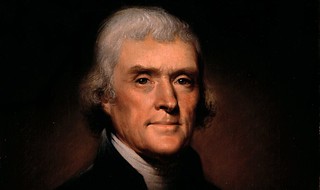 Thomas Jefferson was born one of the richest men in the American colonies. At the age of 14, he inherited 5,000 acres and 52 slaves from his father. Later, he and his wife, Martha, inherited 11,000 acres and 135 slaves from his father-in-law, John Wayles. But as one of the largest planters in the country, he had an aristocratic disdain for those who engaged in commerce—especially banking—a business that makes money from money, rather than from what Jefferson rather ironically regarded as
Thomas Jefferson was born one of the richest men in the American colonies. At the age of 14, he inherited 5,000 acres and 52 slaves from his father. Later, he and his wife, Martha, inherited 11,000 acres and 135 slaves from his father-in-law, John Wayles. But as one of the largest planters in the country, he had an aristocratic disdain for those who engaged in commerce—especially banking—a business that makes money from money, rather than from what Jefferson rather ironically regarded as honest toil.
American banking began only in 1784, as before independence Great Britain had forbidden banks in the colonies. Alexander Hamilton, the first secretary of the treasury, established the Bank of the United States, modeled on the Bank of England, to act as the central bank and provide discipline to the emerging American banking system.
To read the complete article, see:
The Ghost of Thomas Jefferson
(https://bankingjournal.aba.com/2021/08/the-ghost-of-thomas-jefferson/)
Remember the guy who bit someone's Olympic gold medal? After 7,000 complaints he's taking a salary cut as punishment. -Editor
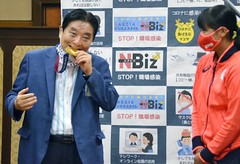 A Japanese mayor who drew criticism for biting an Olympic champion's gold medal has offered to take a three-month pay cut as punishment.
A Japanese mayor who drew criticism for biting an Olympic champion's gold medal has offered to take a three-month pay cut as punishment.
Nagoya Mayor Takashi Kawamura chomped on the gold medal of Miu Goto, a pitcher for Japan's softball team, during a victory event earlier this month.
Speaking at a press conference, Kawamura has now said he is ready to forfeit three months' pay totaling 1.5 million yen ($13,000) as a penance for his indiscretions.
Goto is set to be given a free replacement medal from the International Olympic Committee.
To read the complete article, see:
A Japanese mayor who bit an Olympian's gold medal has offered to forfeit $13,000 of pay as a punishment
(https://www.insider.com/tokyo-olympics-japan-mayor-bit-olympians-gold-medal-pay-cut-2021-8)
To read the earlier E-Sylum article, see:
JAPANESE MAYOR BITES OLYMPIAN'S GOLD MEDAL
(https://www.coinbooks.org/v24/esylum_v24n34a26.html)
Gerry Tebben passed along this Wall Street Journal article on the tussle between Serbia and Croatia over inventor Nikola Tesla. Thanks. -Editor
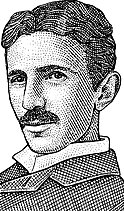 This summer, the governor of Serbia's central bank is taking an aggressive position on a foreign currency: Trying to stop inventor Nikola Tesla appearing on Croatia's coins.
This summer, the governor of Serbia's central bank is taking an aggressive position on a foreign currency: Trying to stop inventor Nikola Tesla appearing on Croatia's coins.
Though dead for 78 years, Mr. Tesla still raises temperatures between these two Balkan neighbors over which one has bragging rights to the pioneering electrical engineer, after whom Tesla Inc.'s electric vehicles were named.
Mr. Tesla was an ethnic Serb and grew up in a part of the Austrian empire that is in modern-day Croatia. In 1884, at 28 years old, he emigrated to the U.S., where he pioneered how to make alternating current work on a grand scale, electrifying the world.
In Belgrade, where the ubiquity of Mr. Tesla's name and image give him a profile typically reserved elsewhere for sport or pop stars, everyone has an opinion, and that opinion is unanimous: Hands off, Croatia.
To read the complete article (subscription required), see:
Tesla Ignites a Feud, and It Has Nothing to Do With Cars
(https://www.wsj.com/articles/tesla-feud-nikola-tesla-croatia-serbia-elon-musk-11629830487)
To read the earlier E-Sylum article, see:
THE TUSSLE OVER TESLA
(https://www.coinbooks.org/v24/esylum_v24n31a31.html)
GIRL CUTS QUEEN'S FACE FROM BANKNOTES
In the aspiring-money-artist department is this story about a girl in England who cut up banknotes to place the Queen's face on her dolls. -Editor
A mother in England was left in hysterics after discovering her child had cut up real banknotes of pound sterling so she could stick Queen Elizabeth's face onto her dolls. The mother, Victoria Ingham, had gone upstairs at her residence to check on her 4-year-old daughter only to find out that she was giving a makeover to her dolls by sticking Queen's face from the currency notes on them.
Posting images on Facebook that went viral, Victoria explained how she did not know 'whether to laugh or cry' about the situation. When she approached her daughter's play zone on the other floor, the mother found her kid surrounded by the remains of £20 and £5 banknotes, both of which were missing the Queen's face.
Interestingly, upon reading the post, many people offered to send Victoria the money, Ladbible stated. After seeing the offers flood in, Victoria's friend set up a www.gofundme.com page. So far, £235 has been raised, all of which will be donated to the children's ward at The James Cook University Hospital in Middlesborough.
To read the complete article, see:
Mom in England left in splits after kid cut Queen's face from banknotes to stick on dolls
(https://m.republicworld.com/world-news/uk-news/mom-in-england-left-in-splits-after-kid-cut-queens-face-from-banknotes-to-stick-on-dolls.html)
To read an earlier E-Sylum article, see:
INTERVIEW: MONEY ARTIST MARK WAGNER
(https://www.coinbooks.org/v21/esylum_v21n40a14.html)
FEATURED WEB SITE: SCHAFLUETZEL'S
This week's Featured Web Site is Dennis & John Schafluetzel's site on Onamastics, Genealogy, History & Numismatics. Topics include Tennessee obsolete banknote and railroad scrip. Found via News & Notes from the Society of Paper Money Collectors (Volume VII, Number 7, August 3, 2021).

